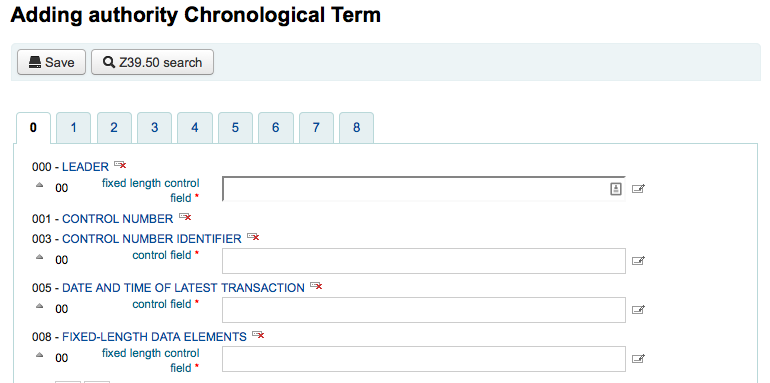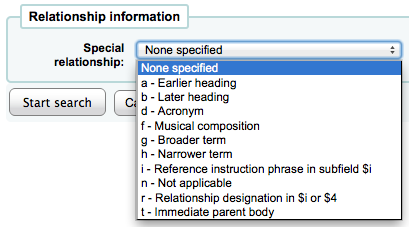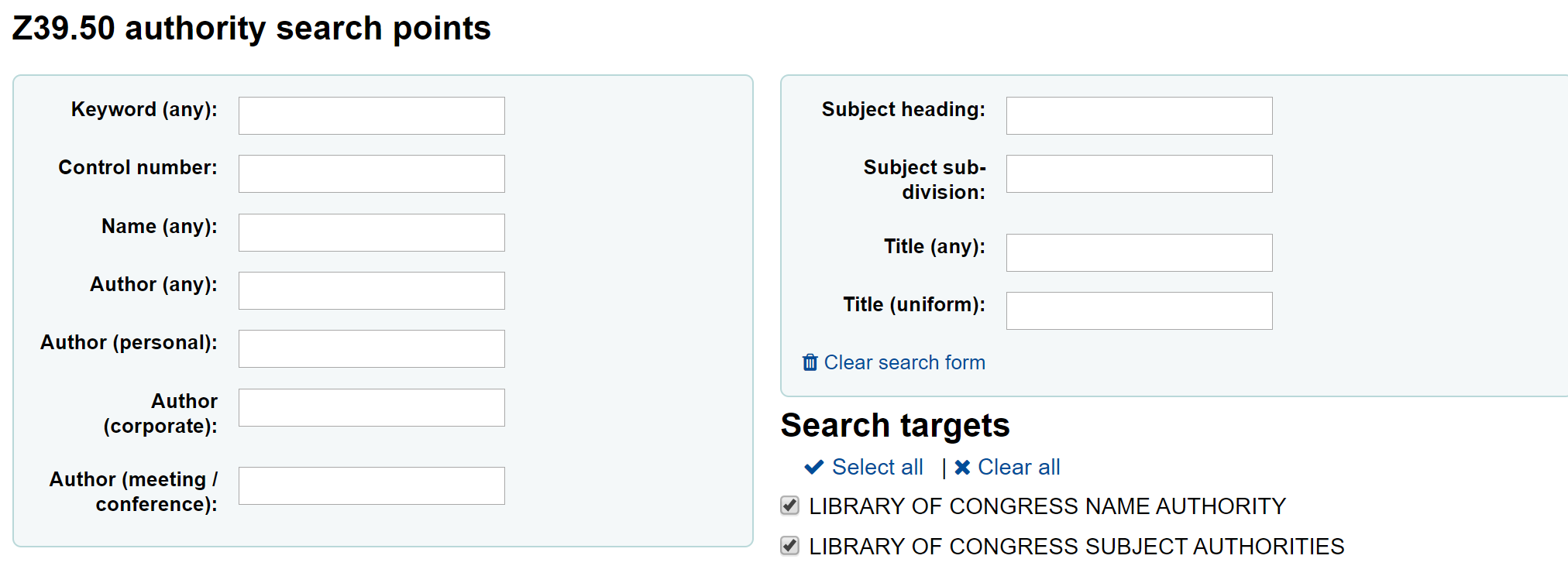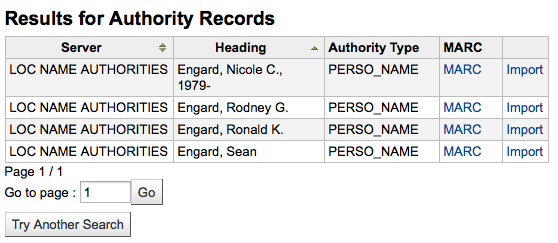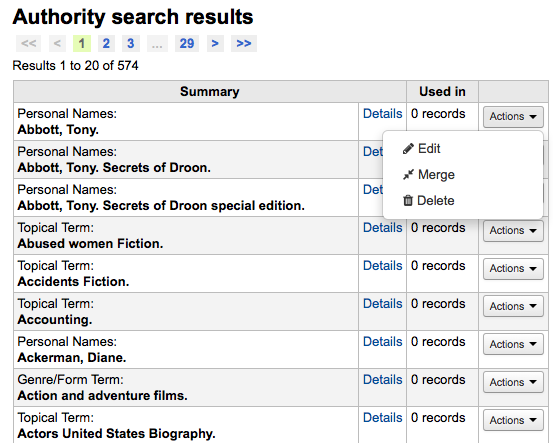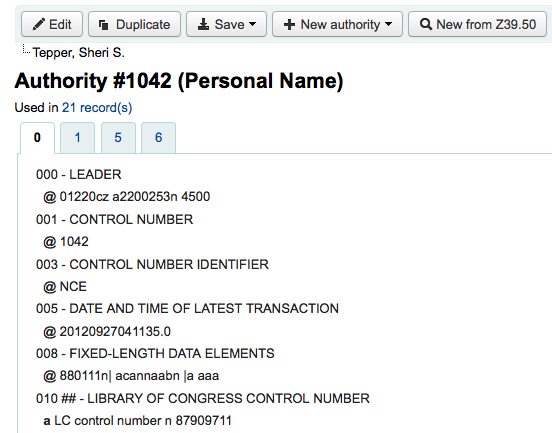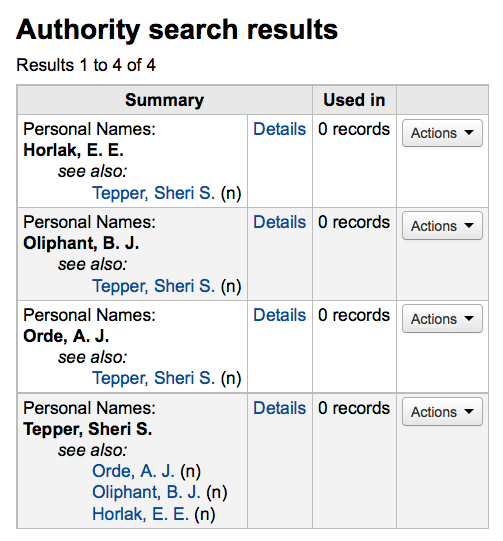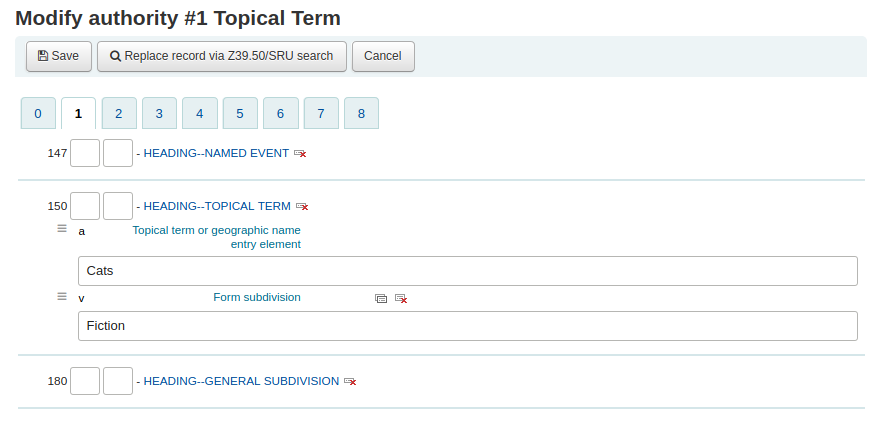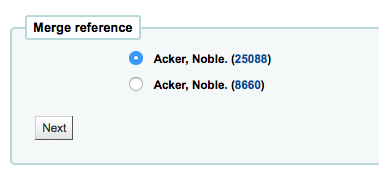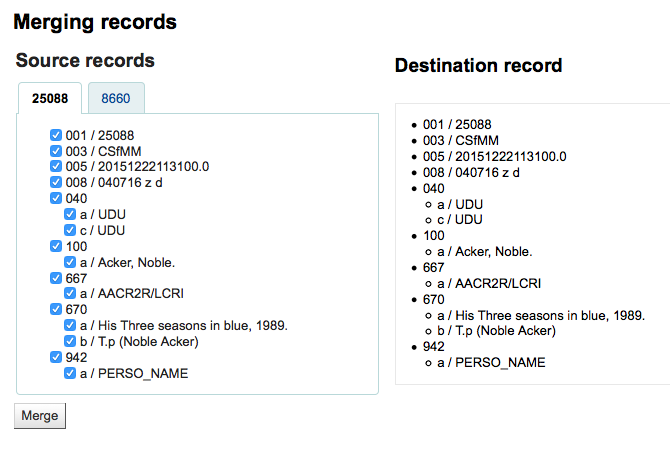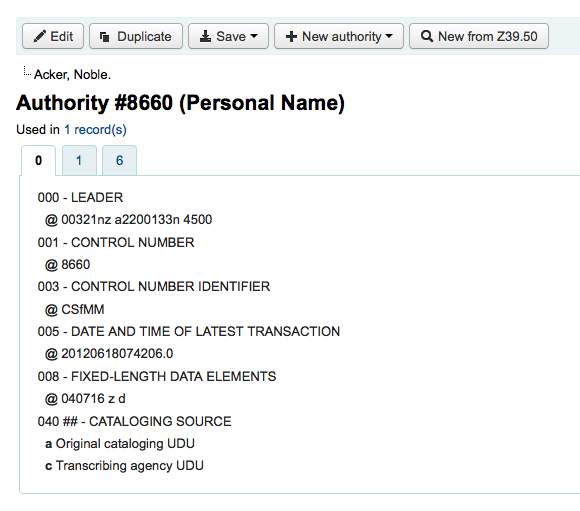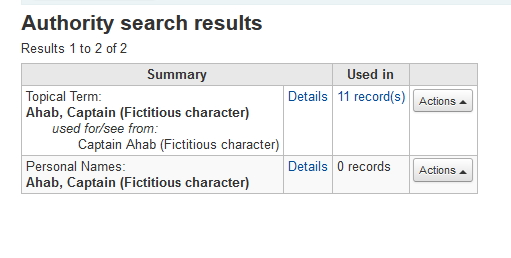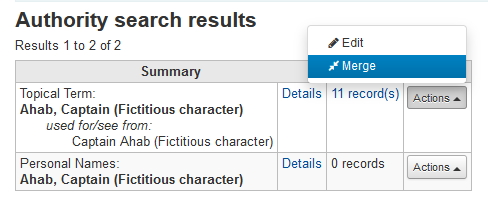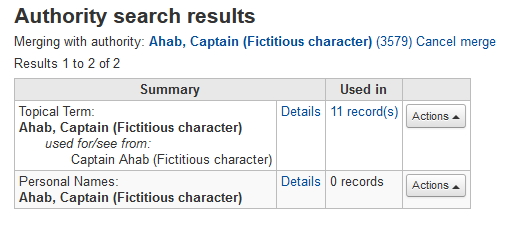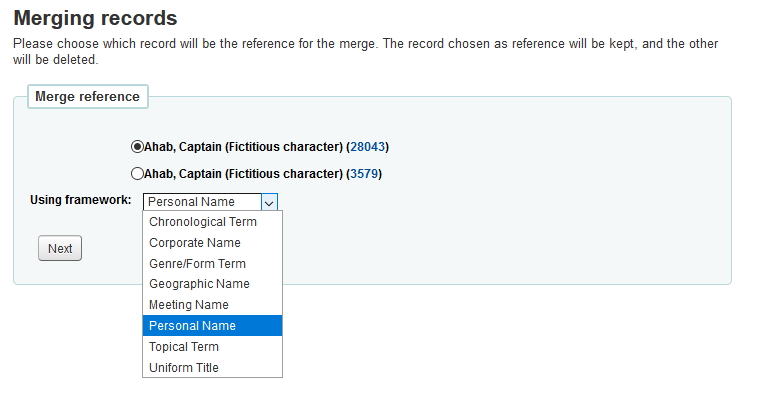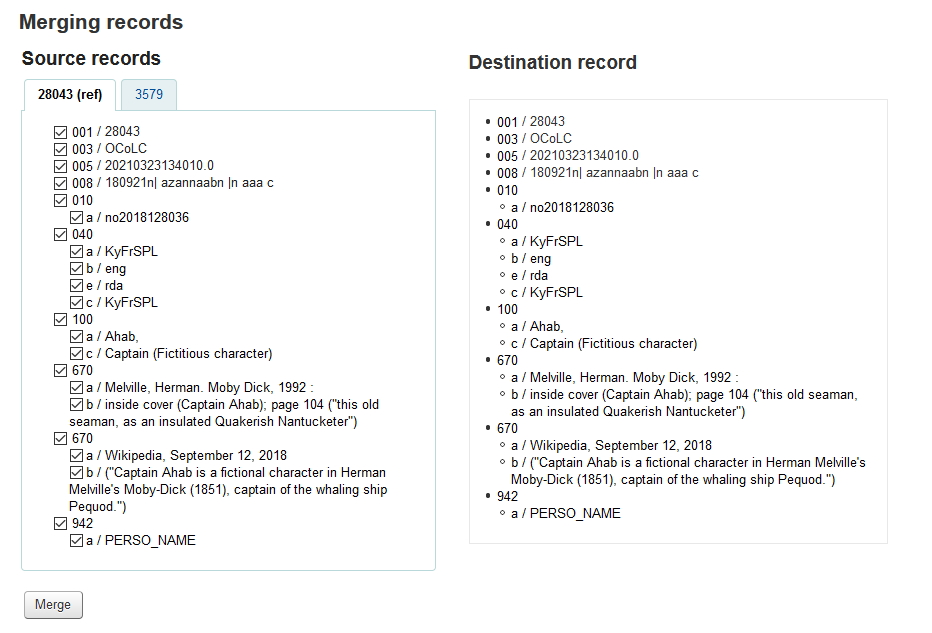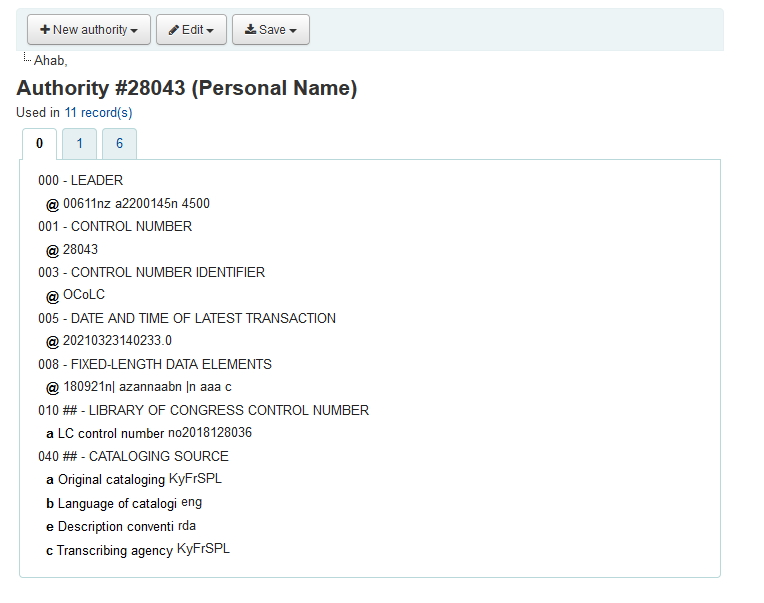Kataloglama
Before you start cataloging in Koha you’re going to want to do some basic setup. Refer to the Implementation checklist for a full list of these things. Most importantly you’re going to want to make sure that your MARC bibliographic frameworks are all defined the way you want. Once in the cataloging module you will not be able to add or remove fields and subfields so your frameworks must be ready before you start cataloging.
Koha’ya kayıtları doğrudan göndermek için OCLC Connexion’da kullanabilirsiniz. Bu konu hakkında daha fazla bilgi almak için lütfen OCLC Connexion Kurulum eki bölümünü gözden geçirin.
Gidiş yolu: Daha fazla > Kataloglama
Bibliographic records
In Koha the bibliographic record contains the main information related to the material. This includes things like the title, author, ISBN, etc. This information is stored in Koha in Marc (different flavors of Marc are supported in Koha). Once this information is saved, item records can be attached.
Adding records
Kayıtlar Koha’ya orijinal ya da kopya kataloglama yoluyla eklenebilir. Aynı zamanda temel ya da gelişmiş kataloglama arayüzünü tüm çalışmanız için kullanmayı seçebilirsiniz.
Bir kaydı temel düzenleyici içindeki bir boş şablonu kullanarak kataloglamak isterseniz
Click ‘New record’

Choose the framework you would like to base your record on
Not
You can create or modify frameworks in the Administration module.
Bir kaydı gelişmiş düzenleyici içindeki bir boş şablonu kullanarak kataloglamak isterseniz
EnableAdvancedCatalogingEditor sistem tercihini etkinleştirin
‘Gelişmiş düzenleyici’ butonuna tıklayın

If you want to catalog a record based on an existing record at another library in the basic or advanced editor
‘Z39.50/SRU’dan Yeni’ üzerine tıklayın
Click on the arrow to pre-select a framework for your imported your catalog record (the Default framework is used if you do not make a selection).
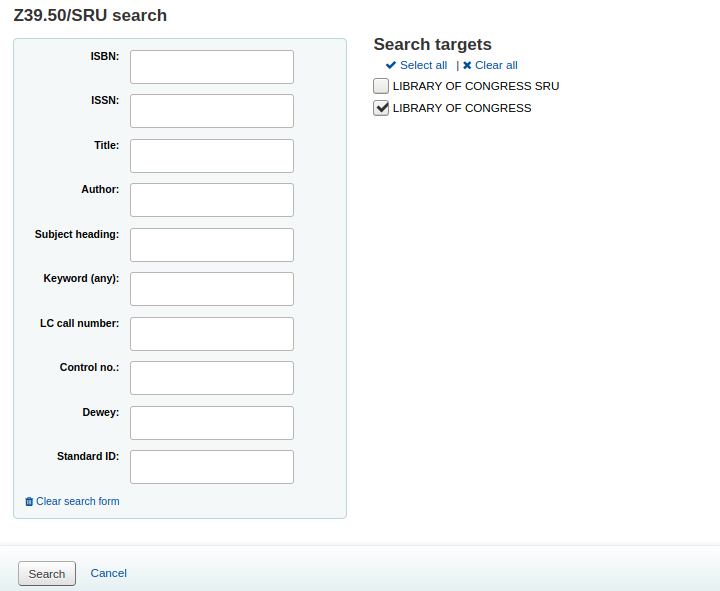
Kataloglamak istediğiniz materyal için arama yapın
Not
Eğer hiç bir sonuç bulunamazsa daha az alanlar için arama yapmayı deneyin, Bazı Z39.50 hedefleri, yukarıdaki alanların tümü için arama yapamayabilir.
Search targets can be altered by using the Z39.50 admin area.
The display of extra MARC fields and subfields can be configured via the AdditionalFieldsInZ3950ResultSearch preference.
From the results’ ‘Actions’ button you can view the MARC or Card view for the record or choose to import it into Koha.
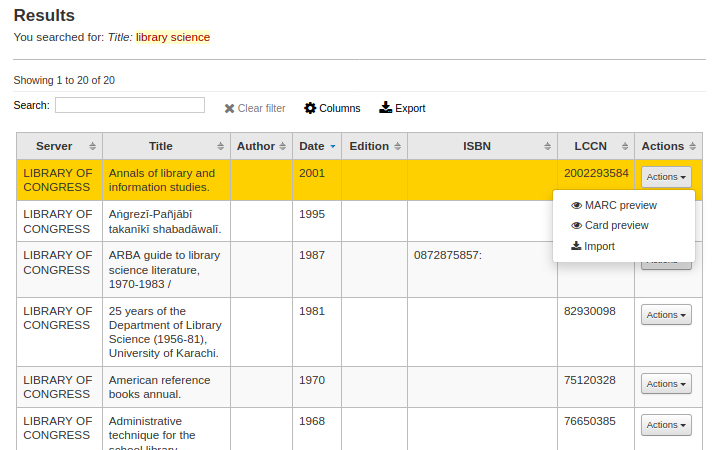
Not
You can customize the columns of this table in the ‘Table settings’ section of the Administration module (table id: resultst).
Z39.50 arama sonuçlarınızda ihtiyacınız olan başlığı bulamıyorsanız, sonuçlarınızın sol altındaki ‘ Diğer aramayı dene’ butonuna tıklayabilirsiniz.
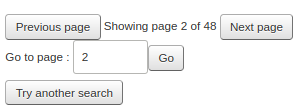
Basic editor cataloging
Temel düzenleyicide boş bir çerçeve açtığınızda ya da Z39.50 yoluyla kayıt aktardığınızda, size kataloglamaya devam etmeniz için bir form sunulacaktır
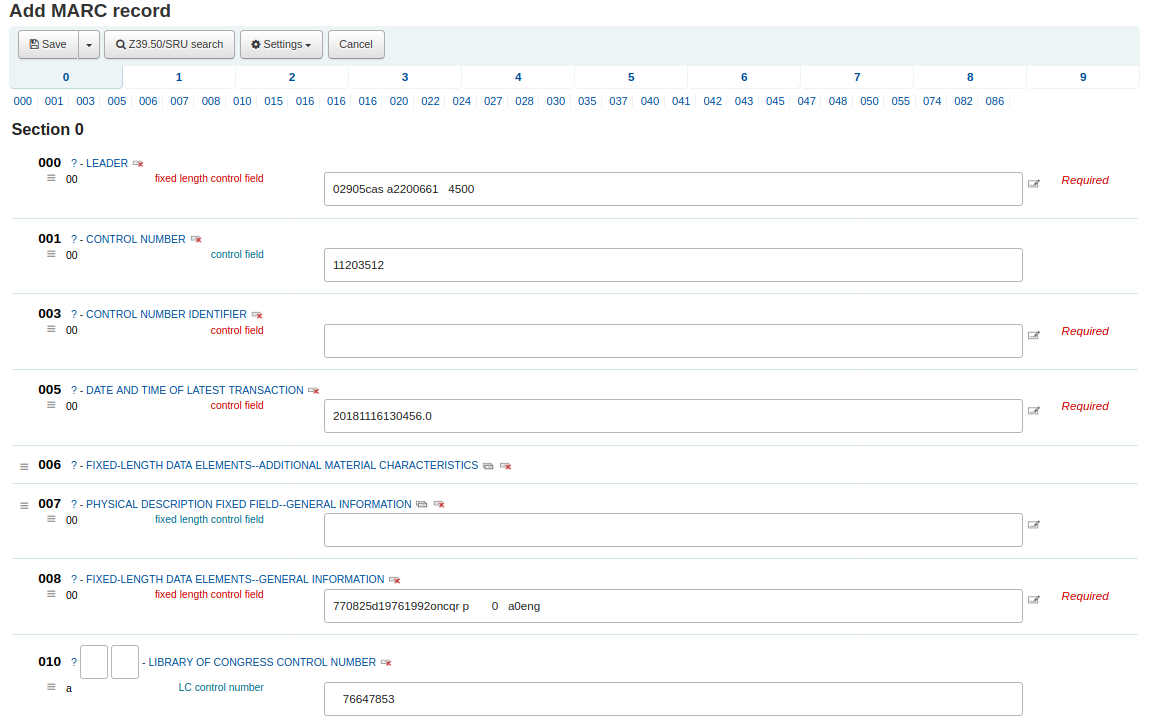
If you would rather not see the MARC tag numbers you can change the value in your hide_marc system preference or each user can check the box next to ‘Show tags’ found under ‘Settings’.
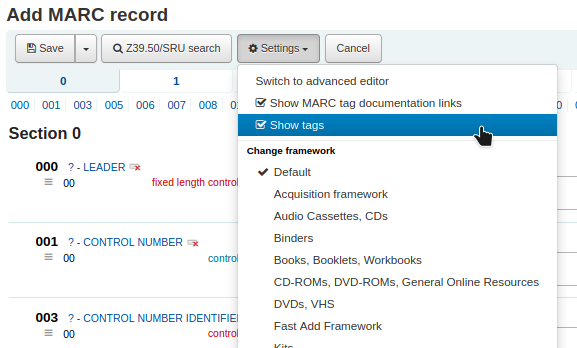
Daraltılmış bir etiketi açmak için etiket tanımına tıklayın.
To get help from the Library of Congress on a MARC tag click the question mark (?) to the right of each field number
It is possible to change the source of the MARC documentation using the MARCFieldDocURL system preference
Bunun ekranı karıştırdığını düşünüyorsanız, ‘Ayarlar’ bölümünde bulunan ‘MARC tag dokümantasyon bağlantılarını göster’ notunun yanındaki kutunun işaretini kaldırarak soru işaretlerini gizleyebilirsiniz.
Bazen alanlar BiblioAddsAuthorities sistem tercihiniz içindeki değerler nedeniyle düzenlenemeyebilirler. Bu sistem tercihini katalogçuların otoriteler tarafından kontrol edilen alanlar içerisinde değişiklik yapmalarına izin vermeyecek şekilde ayarladıysanız, alanların solunda bir kilit sembolü göreceksiniz.

Bu ikon ekrana gelirse, mevcut otoriteyi aramak için alanın sağındaki ikona tıklamanız gerekir.
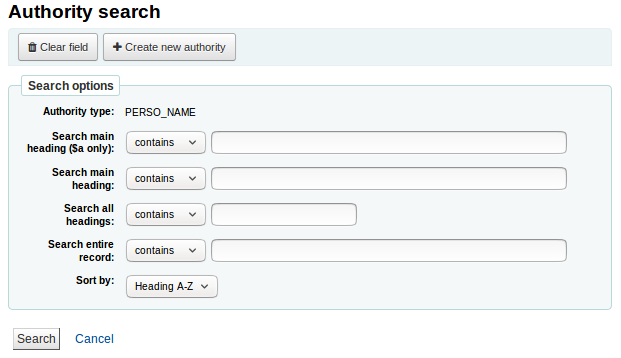
Sonuçlar listesinden, bu sonucu katalog kaydına taşımanız için ‘Otorite seç’e tıklayın.

Bir alanı çoğaltmak için tag’in sağındaki ‘bu tag’i yinele’ simgesi üzerine tıklayın

Alt alanları doğru bir düzene sokmak için, yukarı oku alanın soluna tıklayın.
Bir alt alanı çoğaltmak için alanın sağındaki kopyala simgesine tıklayın. (Kopyalanmış bir alanı kaldırmak için kopyayı sil simgesine tıklayın )

Bir alt alanı kaldırmak için, (aynı türden birden fazla mevcutsa ), alanın sağındaki - (eksi işaretine)tıklayın.
To use a plugin click on the icon to the right of the field

Bazı sabit alanların katalogladığınız materyal tipine bağlı olarak (örneğin 006 ve 008 alanları) değişecek metin düzenleyicileri mevcuttur.
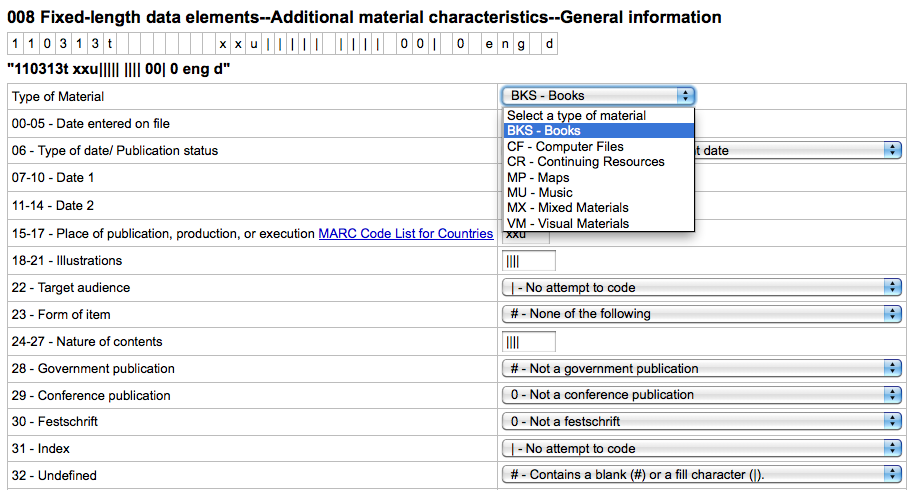
Bitirdikten sonra, en üstteki ‘Kaydet’ düğmesine tıklayarak oluşturduğunuz bib. kaydı görüntülemek ve kaydetmek veya kayda bağlı materyaller ekleme/düzenleme yapmaya devam etmek isteyip istemediğinizi seçin
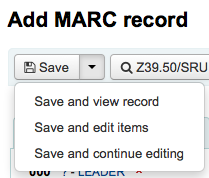
‘Kaydı kaydet ve göster’ seçeneği sizi kataloglamış olduğunuz son kayda götürecektir
‘Materyalleri kaydet ve düzenle’ seçeneği size materyal ekle/düzenle formu getirecektir böylece kaydı kaydettikten sonra ayırma ekleyebileceksiniz
‘Kaydet ve düzenlemeye devam et’ seçeneği şu ana kadar yapmış olduğunuz çalışmayı kaydederek, çalışmaya devam etmeniz için sizi düzenleyici içerisinde tutar
Sisteme dublike kaydı eklemek üzereyseniz, kaydetmeden önce uyarılacaksınız.

Not
To find possible duplicates, the system searches for the ISBN, and if there is not ISBN, it searches for the same combination of title and author.
Advanced editor cataloging
Gelişmiş kataloglama düzenleyiciyi kullanmak için EnableAdvancedCatalogingEditor tercihini etkinleştirmeniz gerekir.
Not
This feature does not currently include any support for UNIMARC or NORMARC fixed fields.
Gelişmiş düzenleyicide boş bir çerçeve açtığınızda ya da Z39.50 yoluyla kayıt aktardığınızda, size kataloglamaya devam etmeniz için bir form sunulacaktır

Soldaki arama kutusunu kullanarak Z39.50 aramaları gerçekleştirebilirsiniz

Ve bu Z39.50 sonuçlarında, sağdaki bağlantıyı tıklayarak marc kaydını görüntüleyebilirsiniz

‘İçe Aktar’ı tıkladığınızda, düzenlemeyi düzenleme yapabileceğiniz editöre götürürsünüz
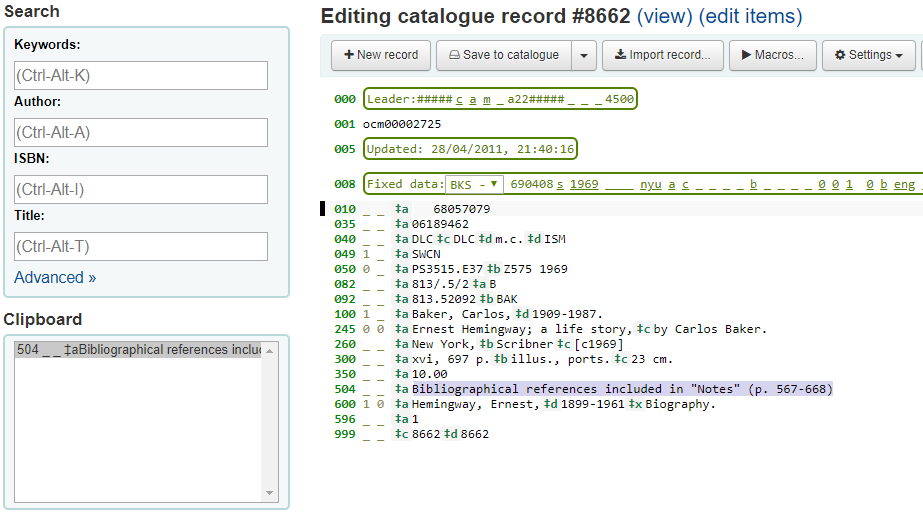
Not
Gelişmiş Düzenleyiciye yeni bir alan eklerken boş bir gösterge için alt çizgiyi tuşlamanız ve göstergeleri boşluklarla çevrelemeniz gerekir.
Not
İlk alt alan sınırlayıcıdan önce bir boşluk tuşlamanız gerekir, ancak alanda diğer alt alan sınırlayıcılarının öncesinde veya sonrasında bir boşluk bırakmanız gerekmez.
At the bottom of the editor you will see help from the Library of Congress for the field you are on. In cases where your MARC is invalid you will see red highlighting. To edit the record using only keyboard functions the Keyboard shortcuts button will inform you of the necessary commands.
A clipboard is available to copy and paste text between fields. See the image and table below for the shortcuts used with the clipboard.
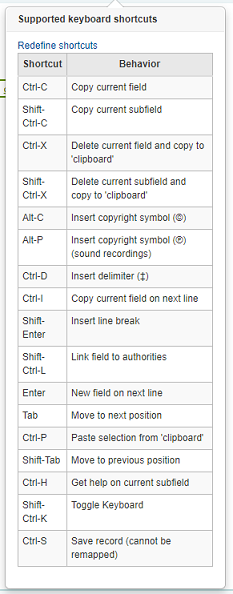
Advanced cataloging keyboard shortcuts
Aşağıdaki klavye kısayolları, tıklama ve zamandan kazanmak için gelişmiş kataloglama modülünde kullanılabilir.
Kısayol |
Davranış |
|---|---|
Ctrl-C |
Copy current field |
Shift-Ctrl-C |
Copy current subfield |
Ctrl-X |
Delete current field and copy to ‘clipboard’ |
Shift-Ctrl-X |
Delete current subfield and copy to ‘clipboard’ |
Alt-C |
Insert copyright symbol (©) |
Alt-P |
Insert copyright symbol (℗) (sound recordings) |
Ctrl-D |
Sınırlayıcı ekle (‡) |
Ctrl-I |
Copy current field on next line |
Shift-Enter |
Satır sonu ekle |
Shift-Ctrl-L |
Link field to authorities |
Giriş |
Bir sonraki satırda yeni alan |
Sekme |
Bir sonraki konuma taşı |
Ctrl-P |
Paste selection from ‘clipboard’ |
Shift-Tab |
Bir önceki konuma taşı |
Ctrl-H |
Geçerli alt alan hakkında yardım alın |
Shift-Ctrl-K |
Toggle Keyboard |
Ctrl-S |
Save record (cannot be remapped) |
Advanced cataloging virtual keyboard

A virtual keyboard is available for adding diacritics and symbols. Use the shortcut Shift-Ctrl-K to display the keyboard. A ‘Keyboard layouts’ button will display at the top of the advanced editor that allows you to set the virtual keyboard layout for different languages.
Macros in advanced cataloging
Yeni bir makro kaydetmek için:
Select the “Macros…” button
Bir pencere açılacaktır. Bu pencerede, “Yeni makro…” seçeneğini seçin ve açılan kutuya yeni makronun adını girin ve Tamam’ı seçin.
Şimdi küçük sayı 1’in sağına tıklayın ve makronuzun ilk satırını tuşlayın. Çok satırlı, yani çok alanlı bir makro için, enter tuşuna basın böylece küçük bir 2 sayısı görünür, ve ikinci satır/alan vb. Tuşlayın.
Makrolarınız otomatik olarak kaydedilecektir. İşlemi tamamladığınızda pencereyi kapatmak için “x” i seçebilirsiniz veya düzenlediğiniz kayıtta çalıştırılacak bir makro seçin veya çalıştırmak için başka bir makro seçin.
Mevcut bir makroyu düzenlemek için:
Select the “Macros…” button
Bir pencere açılır. Bu pencerede, düzenlemek istediğiniz makroyu seçin ve değişikliklerinizi yapın.
Çalışmanız otomatik olarak kaydedilecektir ve işiniz bittiğinde pencereyi kapatmak için “x” i seçebilirsiniz veya düzenlediğiniz kayıtta çalıştırmak için bir makro seçin veya çalıştırmak için başka bir makro seçin.
Makro dilinin temel söz dizimi:
yeni 500=‡aRancor ile düzenlenmiş
‡a alt alanı olan yeni bir 500 oluşturur ve onu “Rancor ile Düzenlendi” olarak ayarlar.
245c= by J.K. Rowling.
Kayıttaki ilk 245 etiketinin ilk ‡c alt alanını, “J.K. Rowling tarafından” olarak ayarlar ve gerekirse onu oluşturur.
082a={084a}
İlk 082 tag’inin ‡a alt alanını (gerekirse alt alanı oluşturarak) ilk 084‡a’nın içeriğine ayarlar.
indicators=_1
Son bahsedilen etiketin göstergelerini (bu durumda, 082) “_” ve “1” e ayarlar.
yeni 090a=Z674.75.W67
İlk 090’da yeni bir ‡a alt alanı oluşturur (sadece o alan zaten varsa) ve onu Z674.75.W67 olarak ayarlar.
sonuna yeni 090a=Z674.75.W67
Yukarıdaki ile aynı.
yeni 245b sonra a = a tale of might and magic /
İlk a alt alanının ardından yeni bir ‡b oluşturur ve onu “a tale of might and magic /” öğesine ayarlar.
245b alanını sil
İlk 245’teki ilk ‡b alt alanını ‡b’ye siler
Adding analytic records
Kütüphaneler bazen monografi ve süreli yayınlar içerisindeki makalelere analitik kataloglama aracılığıyla kullanıcıların erişmesini sağlarlar. Analitik kataloglama, bir kitap, bir süreli yayın ya da bir gazete içerisinde yer alan makale gibi daha geniş bir kaynağın içerisinde bulunan bu makaleler, bölümler, kesitler, vb. için ayrı bibliyografik kayıtlar oluşturur. Analitik kataloglamada başlık için ayrı bir bibliyografik kayıt oluşturulsa da bu kayıt kaynak materyalden fiziksel olarak ayrılmaz. Analitikler hakkında AACR2’nin 13. bölümünde daha ayrıntılı bilgi bulabilirsiniz.
If you would like to catalog analytic records there are two options. One is to use the Easy analytics function; the other is the Analytics enhanced workflow.
Easy analytics
The easy analytics feature makes linking analytic records together easier. The first thing you need to do is set the EasyAnalyticalRecords preference to ‘Display’ and the UseControlNumber preference to ‘Don’t use.’
After cataloging your analytic record (see adding records for more on creating records) click ‘Edit’ from the normal view and choose to ‘Link to host item’
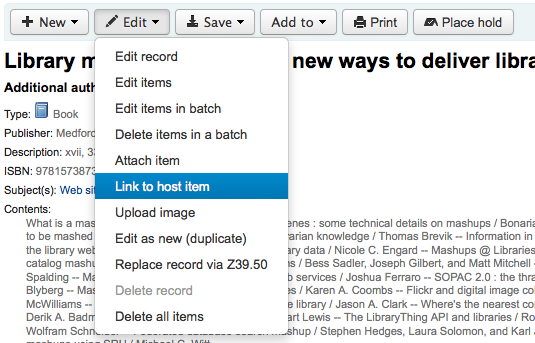
Bu, bu kaydın bağlı olması gerektiği materyale barkot girmeniz için hatırlatma yapacaktır.

Materyalin barkodunu girip ‘Seç’ üzerine tıkladıktan sonra karşınıza bir onay mesajı gelecektir.

Mevcut bağlantıyı düzgünce tamamlamak üzere kaydın şu anda 773 alanını dolduracak
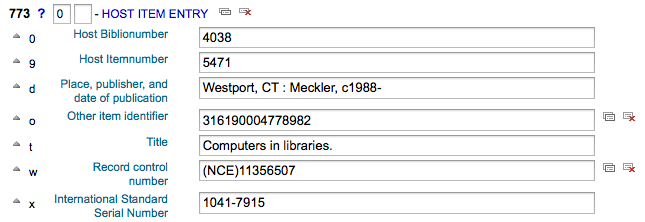
To view all of the items tied to the host record, do a search for the record, click the ‘Analytics’ tab on the left and the analytics tied to each barcode will be shown under the ‘Used in’ column.

Not
It is also possible to create analytic records from this screen by clicking on ‘Create analytics’
You can also see the analytics attached to this record by clicking the ‘Show analytic’ link towards the top of the record in the normal view.

Analitik kayda bakıldığında, ‘Analytics’ sekmesini görüntülerken holdings tablosundaki ‘Ana bilgisayar kayıtları’ sütununun altındaki ana materyale bir bağlantı da göreceksiniz.

Analytics enhanced workflow
To use the enhanced workflow method of adding analytics, the first thing you need to do is set the EasyAnalyticalRecords preference to ‘Don’t display’ and the UseControlNumber preference to ‘Use.’
After cataloging your original record (see adding records for more on creating records) click ‘New’ from the normal view and choose to ‘New child record.’
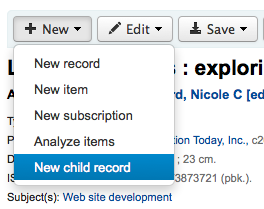
This will open a new blank record for cataloging. The blank record will have the 773 field filled in properly to complete the link once the record is saved.

The ‘Show analytics’ link from the host record will now use the hosts record control number (001) to search for all records on the system of the type ‘monographic component part’ or ‘serial component part’ (Leader position 7) with a 773 subfield w that contains the hosts record control number.
Editing analytics
If you have linked an analytic record incorrectly you can remove that link by editing the analytic record (not the host record).
To do this, go to the analytic record and click the ‘Edit’ button. For UseControlNumber simply edit or remove the corresponding 773.
If using EasyAnalytics choose to ‘Edit items’; To the left of each item you will see two options.

Clicking ‘Edit in host’ will allow you to edit the item on the host record.
‘Bağlantıyı kaldır’a tıklamak 773 alanın ve analitik ile sunucu arasındaki bağlantıyı silecektir.
Editing records
To edit a record you can click the ‘Actions’ button and choose ‘Edit biblio’ from the search results on the cataloging search page

ya da Bibliyografik Kayıt üzerindeki Düzenle butonunu tıklayıp ‘Kaydı Düzenle’ opsiyonunu seçebilirsiniz
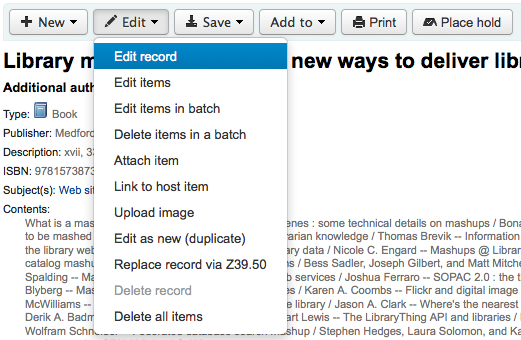
Kayıt MARC editöründe açılacaktır

The alternative is to search via Z39.50 to overlay your record with a fuller record found at another library. You can do this by choosing ‘Replace record via Z39.50/SRU’ from the ‘Edit’ menu.
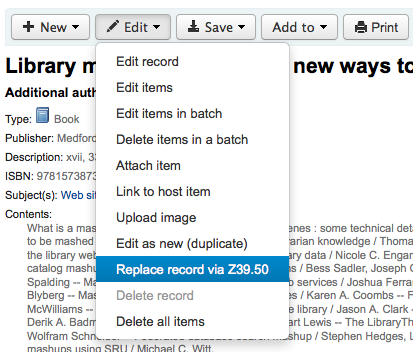
Once you choose that, you will be brought to a Z39.50 search window to search other libraries for the record in question.
Düzenlemelerinizi yaptığınızda (ya da metot yoluyla), metin düzenleyicinin en üst solundaki ‘Kaydet’e tıklayabilirsiniz.
You can also use the edit menu to add your own custom cover image if you have either OPACLocalCoverImages and/or LocalCoverImages set to ‘Display’ by choosing ‘Upload image’ from the menu.
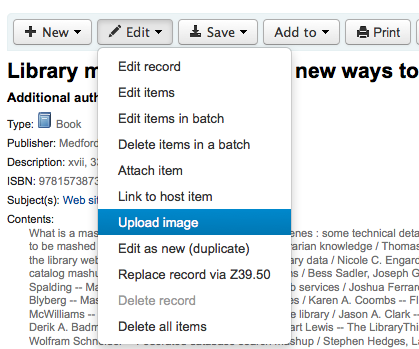
Choosing ‘Upload image’ will take you to the Upload Local Cover Image Tool.
Duplicating records
Sometimes a copy of the record you need to catalog can’t be found via Z39.50. In these cases you can create a duplicate of similar record and edit the necessary pieces to create a new record. To duplicate an existing record click ‘Edit as new (duplicate)’ from the ‘Edit’ menu on the bibliographic record.
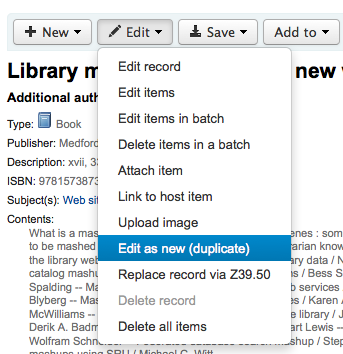
This will open a new MARC record with the fields filled in with the values from the original bibliographic record.
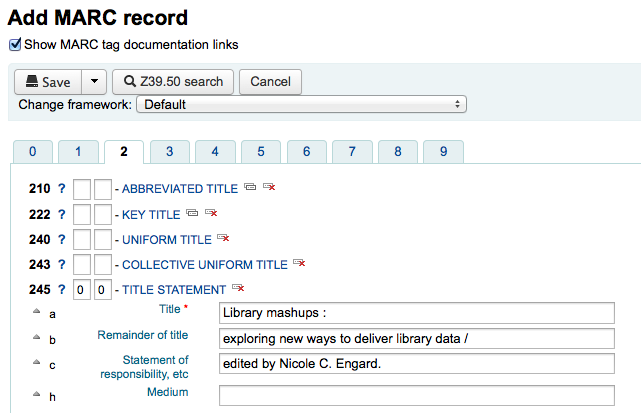
Attaching files to records
Koha’ya dosya yüklemek isterseniz bunu birkaç ayarlarla yapabilirsiniz.
Sistem yöneticinizden, ‘upload_path’ yapılandırma değişkenini dosyaların saklanacağı yeri işaret edecek şekilde ayarlamasını istemeniz gerekecektir
You can see if your upload path is set correctly by visiting About Koha > System information. If there is an error you will see it there.

OPACBaseURL sistem tercihinin doğru olarak ayarlandığından emin olmalısınız
You will want to add the upload.pl plugin to the 856$u subfield in one (or multiple) of your frameworks
Tamamlandığında düzenli olarak kataloglamaya devam edebilirsiniz. 856$u’nun yanında, yükleme ve/veya arama penceresini açacak bir eklenti simgesi göreceksiniz
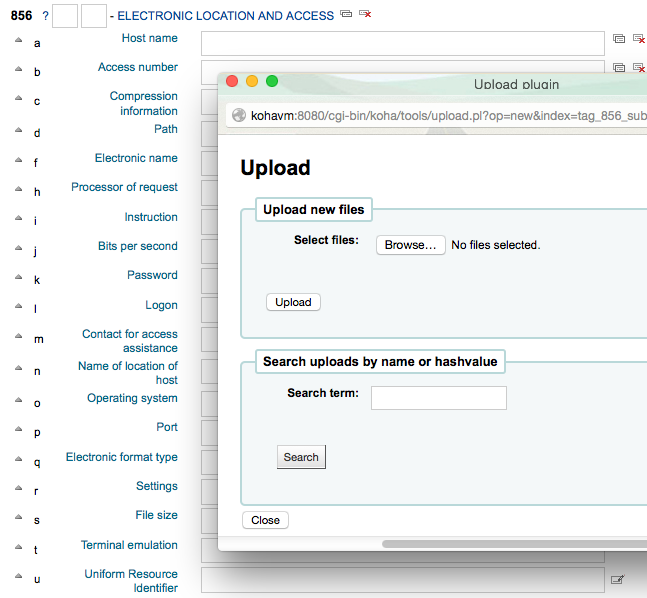
Bu menüden bir dosyayı bulmak ve eklemek için gözat’ı tıklayabilir veya arama kutusunu kullanarak daha önce yüklediğiniz dosyaları arayabilirsiniz. Arama sonuçlarında hangi dosyanın ekleneceğini seçebilirsiniz.
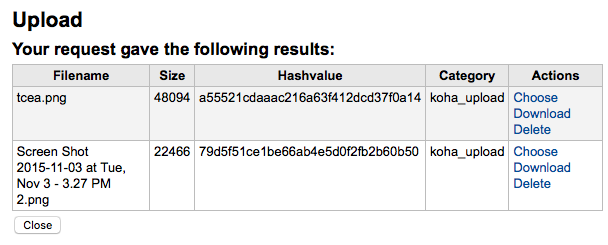
Dosya seçildikten sonra MARC kaydında ve detay ekranında bir bağlantı olarak görünür.

Not
If the file is a PDF, it will be opened directly in the user’s browser whereas if the file is an image or another type of file, the user will be prompted to download it.
Merging records
Bibliyografik kayıtları bir arada birleştirmek için Kataloglama modülüne gidin ve bir arama gerçekleştirin.
Arama sonuçları ekranında kopyalar görürseniz, kopyaların yanındaki kutuları işaretleyebilir ve sonuçların üst kısmındaki ‘Seçilenleri birleştir’ düğmesini tıklayabilirsiniz.
Birleştirmek istediğiniz kayıtları seçtikten sonra listenin en üstündeki ‘Seçilenleri Birleştir’ butonuna tıklayın. İki kayıttan hangisini birincil kayıt olarak tutmak istediğiniz ve hangisi kayıtın birleştirme işleminden sonra silineceği sorulacaktır. Eğer kayıtlar farklı çerçeveler kullanılarak oluşturuldu ise, Koha aynı zamanda yeni birleştirilen kayıtın hangi çerçeveyi kullanmasını istediğinizi de soracaktır.

Size her iki kayıt için MARC sunulacak ( bu kayıtların her birine bibliyografik kayıt numaralarıyla etiketlenmiş sekmelerle ulaşılabilir ). Varsayılan olarak birinci kaydın tamamı seçilecektir, son (hedef dosya) kayıttaki istemediğiniz alanların onay işaretini kaldırınız ardından son (hedef dosya) kayıtta olması gereken alanları seçmek için ikinci sekmeye ilerleyiniz.
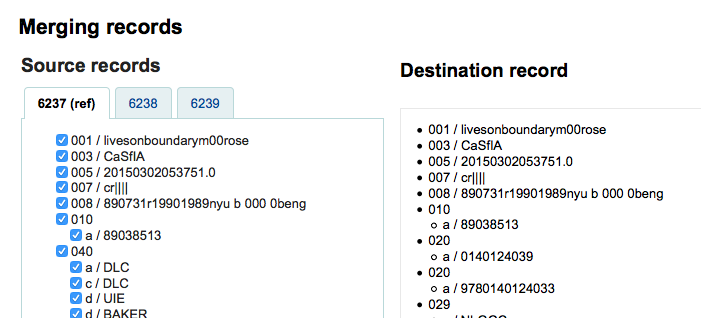
İki defa tekrar edilmeyen bir alan eklemeye çalışıyorsanız (245. alandan hem 1 nolu hem de 2 nolu kaydı seçmek gibi)size hata mesajı verilecektir.

Birleşmekte olduğunuz kayıtların altında, raporlanacak alanları girmek için bir seçenek var. Bu, birleştirme onay sayfasında hangi alanları gördüğünüzü kontrol etmenizi sağlayacaktır:

Hiçbir şey girmezseniz karşınıza yalnızca bibliyo numaralarının onayı gelecektir
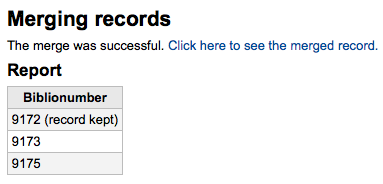
Alanlara girerseniz, onay sayfasında bunları görebilirsiniz (varsayılanları :ref:”MergeReportFields` tercihiyle ayarlayabilirsiniz)
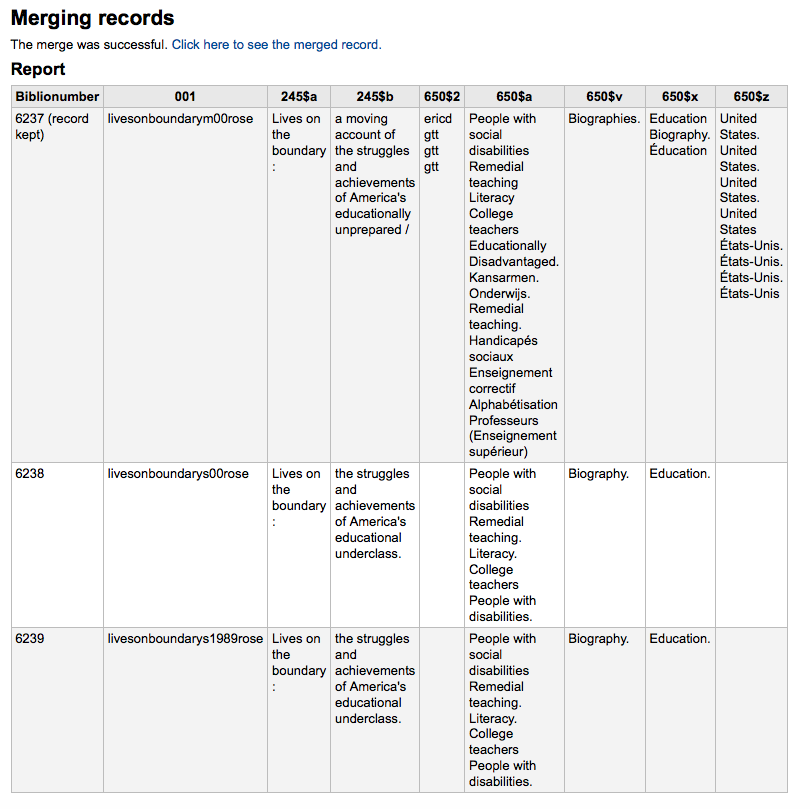
Seçimlerinizi tamamladığınızda ‘birleştir’ butonuna tıklayın. Ana kayıt kendisi için seçtiğiniz veriyi içermekle birlikte her iki bibliyografik kaydın materyallerini/ayırtmalarını da içerecektir, ve ikinci kayıt silinecektir.
Not
If you would like you can also use the Lists tool for merging records together. Learn more here.
Deleting records
Bir bibliyografik kaydı silmek için ‘Düzenle’ butonuna tıklayıp ‘Kaydı sil’ seçeneğini seçmeniz yeterlidir.
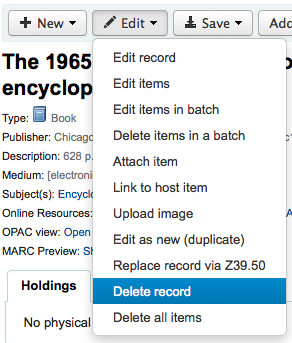
Bibliographic records can only be deleted once all items have been deleted. If you try to delete a bibliographic record with items still attached you will see that the delete option is grayed out.
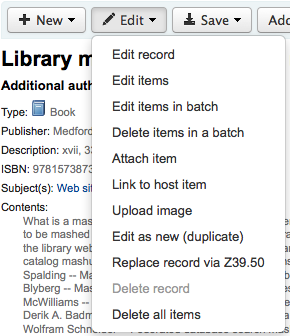
Item records
Koha içerisinde her bibliyografik kayda bir ya da daha fazla materyal bağlanabilir. Bu materyaller bazen ayırmalar olarak adlandırılır. Her materyal, kütüphanede bulunan fiziksel kopya ile ilgili bilgi içerir.
Adding items
After saving a new bibliographic record, you will be redirected to a blank item record so that you can attach an item to the bibliographic record. You can also click ‘Add/Edit items’ from the cataloging search results

or you can add new item at any time by clicking ‘New’ on the bibliographic record and choosing ‘New item’
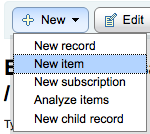
Materyal düzenleme formu gözükecektir:

Materyali dolaşıma koymak istiyorsanız, en azından aşağıdaki alanları doldurmanız gerekir:
2 - Sınıflama kaynağı
a- Kalıcı yer
b- Geçerli konum
0- Tam çağrı numarası
If you’d like you can use the cataloguing plugin ‘call number browser’ (cn_browser.pl) for this field. If it’s enabled you’ll see a … to the right of the field. When clicked that will open a call number browser window if the row is highlighted in Red then the call number is in use, if there is a thin Green line instead then the call number can be used.

p- Barkod
v - Maliyet, yerine koyma fiyatı
Bu değer, ödünç aldıkları materyali ‘Kayıp’ olarak işaretlediğinizde kullanıcılardan tahsil edilecektir
y - Koha materyal türü
Bu değerlerin girildiğinden emin olmak için kullanmakta olduğunuz çerçeve içerisinde bu değerleri gerekli olarak işaretleyebilirsiniz ve böylece ‘gerekli’ etiketi ile birlikte kırmızı renkte görünecektir. Materyal, gerekli alanlar doldurulmadan kaydedilemeyecektir.

Not
Materyal alt alanlarını bir çerçeve içerisinde gerekli hale getirmek için çerçeve düzenleyici içerisindeki 952 alanını düzenleyebilirsiniz.
You can add a new authorized value directly from the add and edit item screen for any fields that are linked to authorized value categories such as Shelving location (subfield$c) or Collection code (subfield$8).
Start to type the authorized value description, if a match is not found you will see the option ‘(Select to create)’.
Click on this option to display a pop-up window where you can create you new authorized value.
The authorized value category will be pre-populated from the field you are using, for example LOC for Shelving location, CCODE for Collection code. Take care when choosing your authorized value code. Refer to the notes on adding new authorized values for the correct format of these codes. Use the Description field for the actual value that will be displayed
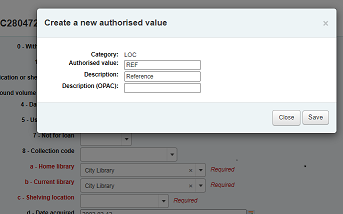
You can add authorized values in the same way from bibliographic and authority records.
Not
You must have the manage_auth_values administration permission to add authorized values from cataloguing.
Below the add form there are 3 buttons for adding the item.

‘Add item’ will add just the one item
‘Add & duplicate’ will add the item and fill in a new form with the same values for you to alter
‘Add multiple items’ will ask how many items and will then add that number of items adding +1 to the barcode so each barcode is unique
Eklemiş olduğunuz materyaller gönderdildikten sonra ekleme formunun üst kısmında görünecektir

Not
You can customize the columns of this table in the ‘Table settings’ section of the Administration module (table id: Items Editor).
Materyalleriniz aynı zamanda bibliyografik kayıt görüntüsü üzerindeki bibliyografik ayrıntılar altında görünecektir.

SpineLabelShowPrintOnBibDetails tercihi ‘Görüntüle’ olarak ayarlı ise, her materyalin yanında hızlı sırt etiketi yazdırmak için bir bağlantı yer alacaktır.

Ayrıca ‘Filtreleri Etkinleştir’ bağlantısına tıklayarak ayırmayalar tablonuzun içeriğini filtreleyebilirsiniz. Bu işlem en üstte, tablodaki sonuçları filtrelemek için herhangi bir sütun içerisine yazabileceğiniz bir satır gösterecektir.

Editing items
Materyaller çeşitli şekillerde düzenlenebilir.
Clicking ‘Edit’ and ‘Edit items’ from the bibliographic record

Düzenlemek istediğiniz belirli materyalin solundaki ‘İşlemler’ düğmesini tıklayıp ‘Düzenle’yi seçebileceğiniz bir materyal listesi açar.
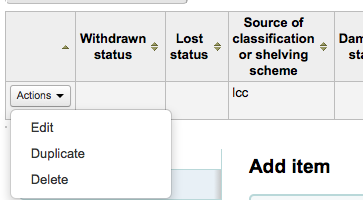
Clicking ‘Edit items’ beside the item on the ‘Items’ tab
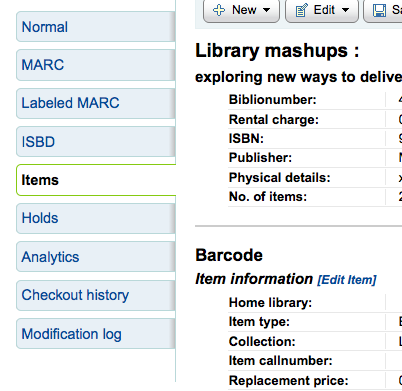
Bu, düzenlemek istediğiniz materyal üzerinde editörü açacaktır
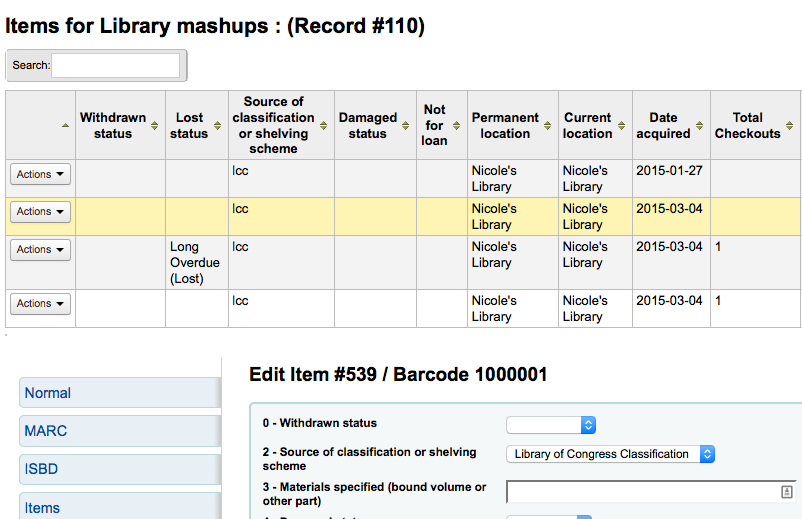
‘Düzenle’ ve sonra ‘Materyalleri toplu olarak düzenle’ üzerine tıklamak
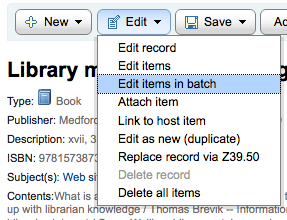
Bu, bu kayıt üzerindeki tüm materyalleri toplu olarak düzenleyebileceğiniz toplu materyal değiştirme aracını açar.
Aynı zamanda, ayrıntılı görüntüleme ekranında her materyalin solunda onay kutularının görünmesi için StaffDetailItemSelection tercihini etkinleştirebilirsiniz. Böylelikle düzenlemek istediğiniz materyalleri işaretleyerek, listenin en üstünde yer alan ‘Seçili materyalleri değiştir’ üzerine tıklayabilirsiniz.
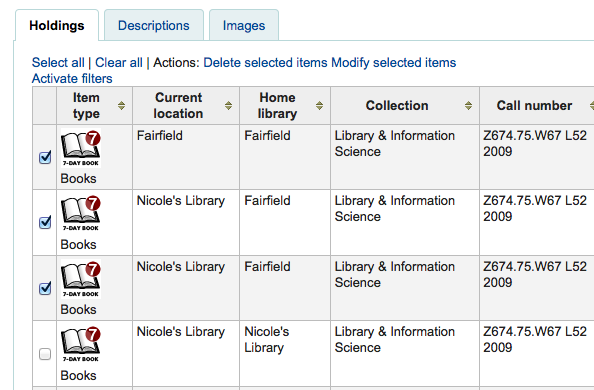
Holdings sekmesinde her materyalin sağındaki ‘Düzenle’ butonu üzerine tıklayabilirsiniz

Personel istemcisindeki arama sonuçlarındaki materyalleri düzenleme bağlantısı da vardır

Finally you can use the batch item modification tool
Quick item status updates
Dolaşım personeli Kayıp ya da Hasarlı bir materyalin durumunu sıklıkla değiştirmek durumunda kalmaktadır. Bu, materyal kaydının tamamını düzeltmenizi gerektirmez. Bunun yerine, materyal barkodundaki ödünç verme özetine ya da iade alma geçmişine tıklamak size materyal özetini sunacaktır. Bibliyografik kayıt detay sayfasının solundaki materyal sekmesine tıklayarak da materyal özetini alabilirsiniz.
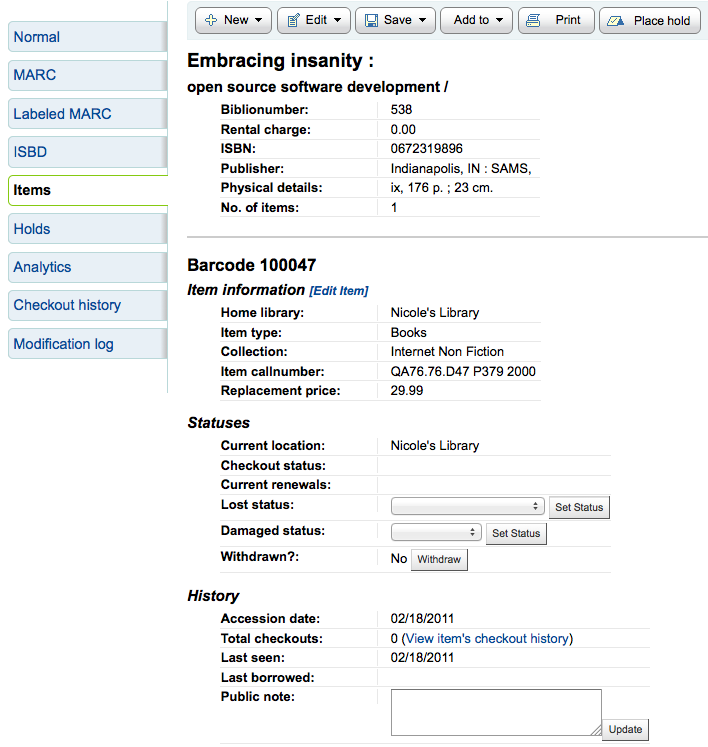
From this view you can mark an item lost by choosing a lost status from the pull down and clicking the ‘Set status’ button.
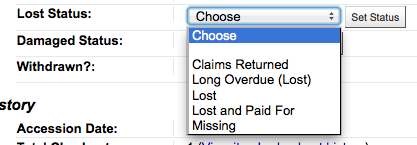
You can also mark an item as damaged by choosing a damaged status from the pull down and clicking the ‘Set status’ button.

Duplicating items
You can easily duplicate each item by clicking the ‘Actions’ button the left of each item on the edit items screen

Buradan materyali ‘Çoğalt’ opsiyonunu seçebilirsiniz ve form seçtiğiniz materyalin değerleri ile doldurulur.
Item information
Her bibliyografik kaydın solunda materyalleri görüntülemek için bir sekme vardır.

Bu sekme üzerine tıklamak materyaller hakkında temek bilgi verecektir. Buradan materyaller hakkında ana kütüphane, materyal türü, koleksiyon kodu, yer numarası ve yenileme bedeli gibi temel bilgileri görebilirsiniz. Aynı zamanda durum bilgisini görebilir ve düzenleyebilirsiniz. Eğer bir materyal kayıp ya da sistemden düşülmüş olarak işaretlenmiş ise, ayrıca durumun uygulandığı tarihi de göreceksiniz.
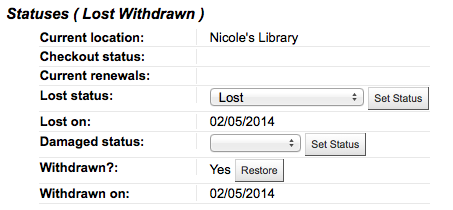
In the ‘History’ section you will see information about the check out history of the item and if you ordered the item via the acquisitions module then this section will include information about the order.
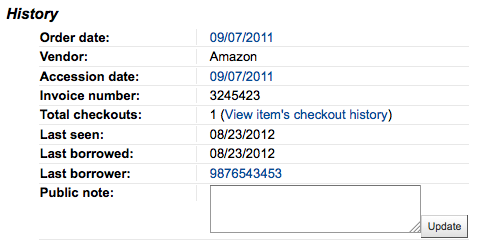
Sipariş ya da Sağlama tarihi bağlantılı ise, bu bağlantı üzerine tıklayınca materyal ile ilgili sağlama bilgisi ekrana gelecektir.
Adding cover images for items
If you have either OPACLocalCoverImages and/or LocalCoverImages set to ‘Display’ you can upload cover images for individual item records from the ‘Upload image’ option from the Edit button on the right of the Holdings table.

Click Choose file to find the image file on your computer and then Upload file.
On the next screen you are given the option to replace existing images. You can then click on Process images.
The image will display in a Cover image column in the holdings display.
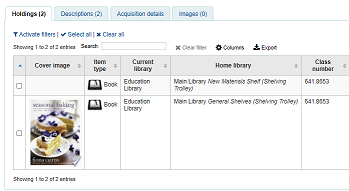
To delete an image, click on the image in the holdings display. You will see a greyed out copy of the image with the option to delete.

Moving items
Items can be moved from one bibliographic record to another using the ‘Attach item’ option
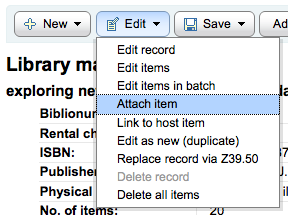
Visit the bibliographic record you want to attach the item to and choose ‘Attach item’ from the ‘Edit’ menu.

Simply enter the barcode for the item you want to move and click ‘Submit’
If this is the last remaining item attached to a bibliographic record you will be presented with a button to delete the original host record.
If you want to move all items to a new record creating only one bibliographic record you can use the merge Records tool instead.
Deleting items
Materyal kayıtlarını silmek için birçok yöntem mevcuttur. Sadece bir materyal silmek gerekiyorsa, bu işlemi bibliyografik kaydı detay sayfasını açarak ve en üstteki ‘Düzenle’ butonuna tıklayarak yapabilirsiniz. Buradan, ‘Materyalleri düzenle’yi seçebilirsiniz.

Size bir materyal listesi sunulacak ve her birinin yanında ‘Sil’ etiketli bağlantı bulunacak. O bağlantıya tıklayınız ve materyal ödünç verilmediyse, bağlantı o materyali silecektir.

Kaydınıza eklenen tüm materyallerin şu anda ödünç verilmediğini biliyorsanız, ‘Menüyü düzenle’nin altındaki ‘Tüm materyalleri sil’ seçeneğini kullanabilirsiniz ve bu işlem kayıttaki tüm materyalleri silecektir.
Ayrıca onay kutularının detay ekranında her materyalin solunda görünür olması için StaffDetailItemSelection tercihini etkinleştirebilirsiniz. Daha sonra silmek istediğiniz materyallerin onay kutularını işaretleyip listenin en üstündeki ‘Seçili materyalleri sil’ bağlantısına tıklayabilirsiniz.

Son olarak, bir materyal topluluğunu silmek için toplu silme aracını kullanabilirsiniz
Item specific circulation history
Her bibliyografik kaydın dolaşım geçmişi mevcuttur (ayarlarınıza bağlı olarak kullanıcı bilgisiyle ya da kullanıcı bilgisi olmaksızın ) fakat her materyalin kendisine ait dolaşım geçmiş sayfası mevcuttur. Bunu görmek için, görüntülediğiniz kaydın solundaki ‘Materyaller’ sekmesine tıklayınız.
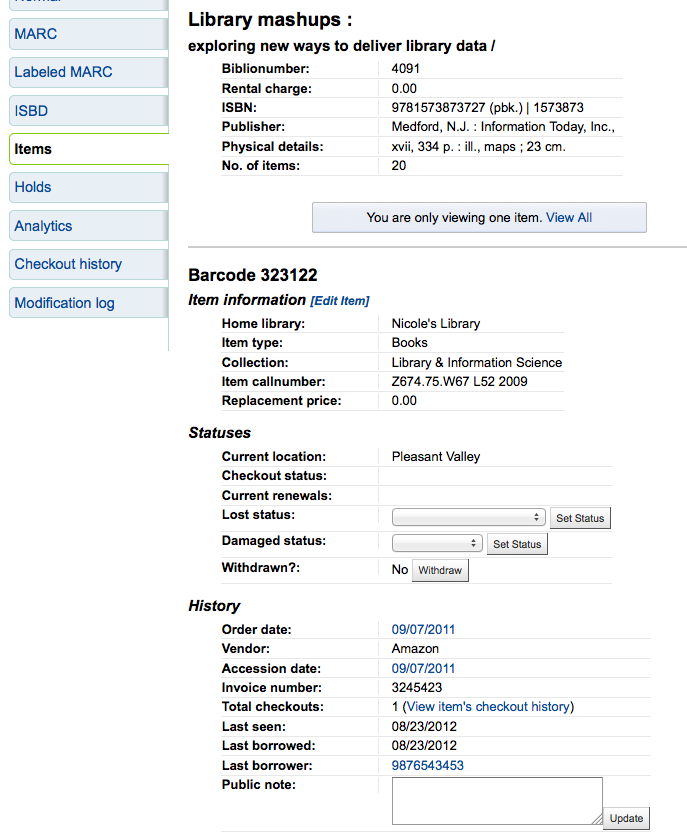
‘Geçmiş’ başlığının altında ‘Materyalin iade geçmişine göz at’ bağlantısı mevcuttur. Bu bağlantıya tıklayınca, bibliyografik kayıt geçmiş sayfasından biraz farklı görünen materyalin geçmişi ortaya çıkacaktır.
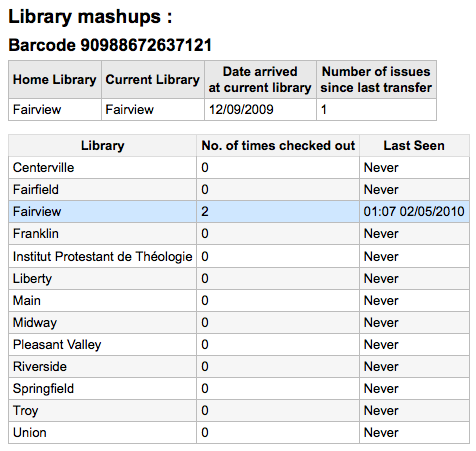
Cataloging guides
Bibliographic record cataloging cheat sheet
Alan kodu |
Etiket |
Tanım |
Talimatlar |
|---|---|---|---|
000 |
LEADER |
Kaydı açıklar (i.e. surrogate) – Bu bir monograf kaydı mı? Bir süreli yayın mı? |
Doldurmak için bu alanı tıklayın. Daha sonra ‘Bibliyografik düzeyi’ makaleler için ‘a’, süreli yayınlar için ‘s’ olarak ayarlayın. Aksi takdirde, her şeyi olduğu gibi bırakın. |
001 |
KONTROL NUMARASI |
Erişim numarası. |
Buraya materyalin içerisinde yazılı olan sağlama numarasını girin. Sağlama numarası bulunmayan makaleler ve materyaller için boş bırakın. |
003 |
KONTROL NUMARASI TANIMLAYICI |
Your MARC organizational code |
İçini doldurmak için bu alanın içine tıklayın (MARCOrgCode tercihiniz ayarlı ise otomatik olarak doldurulacaktır). |
005 |
D & T EN SON İŞLEM |
Geçerli tarih ve saat. |
İçini doldurmak için bu alanın üzerine tıklayın. |
008 |
SABİT-UZUNLUKTA VERİ ÖĞELERİ |
Bir kaç şeyin bilgisayar tarafından okunabilen temsilini içeren alan. |
Genellikle pozisyon 06 için sadece ‘s’ (tek) ya da ‘m’ (birden fazla) seçeneklerini kullanacaksınız -materyal yek bir yıl içinde yayımlandı ise ilk seçeneği, bir kaç yıl boyunca yayımlandığında ise ikinci seçeneği kullanın. Tek bir tarih varsa, ilk tarih alanı içine (07-10 pozisyonları) sadece bir tarih girin. Pozisyon 15-17 içine üç basamaklı ülke kodunu girin, ülke kodu üç karakter uzunluğundan az ise boşluk eklediğinizden emin olun. Eğer bir dizin varsa, bu durumu pozisyon 31 içerisinde belirtin. 35-37 pozisyonları içinde üç harfli dil kodunu girin. |
010 |
LCCN |
İşi benzersiz şekilde tanımlamak için Kongre Kütüphanesi tarafından atanan numara. |
Kitabın telif hakkı sayfasını kontrol edin (ABD’de yayımlandıysa) veya bu numara için LC kataloğunu denetleyin. Eğer bulamazsanız endişelenmeyin. |
020 |
ISBN |
Kitapları tanımlamak için yayıncılar tarafından kullanılan özgün numara. |
Bu sayı kitapta yer almıyorsa muhtemelen yoktur. |
022 |
ISSN |
Süreli yayınları tanımlamak için yayıncılar tarafından kullanılan özgün numara. |
Bu sayı kitapta yer almıyorsa muhtemelen yoktur. |
033 |
OLAYIN TARİH/SAATİ |
Açık artırma tarihleri için kullanılır. Müzayede katalogları için gereklidir. |
Sadece bir gün süren müzayedeler için alt alan ‘a’ içine YYYYAAGG biçiminde müzayede tarihini girin ve ilk indikatörü ‘0’ olarak ayarlayın. Birbirini izleyen iki gün boyunca gerçekleşen ya da ardışık olmayan günlerin sayısınca süren müzayedeler için, her gün için bir ‘a’ alt alanı oluşturun ve tarihi YYYYAAGG biçiminde girin ve ilk indikatörü ‘1’ olarak ayarlayın. Birbirini izleyen iki günden daha fazla süren müzayedeler için ilk gün için bir ‘a’ alt alanı oluşturun (YYYYAAGG biçiminde) ve son gün için de bir ‘a’ alt alanı oluşturun (yine YYYYAAGG biçiminde) ve ilk indikatörü ‘2’ olarak ayarlayın. |
040 |
KATALOGLAMA KAYNAĞI |
Kaydı hangi kütüphanelerin oluşturduğunu ve değiştirdiğini tanımlar. |
Aktarılan kayıtlarda değer olarak OCLC kodunuzla birlikle bir ‘d’ alt alanı ekleyin. Yeni kayıtlar için değer olarak OCLC kodunuzla birlikle bir ‘c’ alt alanı olmasından emin olun. |
041 |
DİL KODU |
İki ya da daha fazla dil mevcut olduğunda bir materyalde kullanılan tüm dilleri tanımlar. |
Belirli bir dildeki metnin önemli kısımları için o dil koduyla birlikte bir ‘a’ alt alanı olmalıdır. Belirli bir dilde yalnızda özetler veya özetçeler varsa, o dil kodu ile birlikte bir ‘b’ alt alanı oluşturun. |
100 |
ANA GİRİŞ–KİŞİ |
Esas yazar adının otorize biçimi |
Bkz: Otorize başlıklar sayfası ve AACR2. İlk indikatör girişin önce soyadı ile yapıldığını göstermek için genellikle ‘1’ olarak ayarlanmalıdır. Yazar adı sadece ön addan oluşuyorsa, bununla birlikte, ilk indikatör ‘0’ olmalıdır. |
110 |
ANA GİRİŞ–KURUM |
Esas kurumsal yazar adının otorize biçimi. Müzayede katalogları için gereklidir. |
Müzayede katalogları bir 100 alanı yerine 110 alanını kullanmalıdır. Otorize başlıklar şemasına ve AACR2’ye bakınız. İlk indikatörü ‘2’ olarak ayarlayın. |
111 |
ANA GİRİŞ–TOPLANTI |
Ana kaynak olarak alınan bir toplantı adının otorize biçimi (örneğin konferans tutanakları) |
Otorize başlıklar sayfası ve AACR2’ye bakın. İlk indikatörü ‘2’ye ayarlayın. |
245 |
ESER ADI BİLDİRİMİ |
Başlık sayfasından başlık bildiriminin uyarlanması (ya da ana bilgi kaynağı) |
Başlığı ‘a’ alt alanına girin ve alt başlığı ‘b’ alt alanına girin, ve sorumluluk bildirimini ‘c’ alt alanına girin. Tek bir cilt ya da birden çok parçalı bir materyalin bir parçası için bir kayıt oluşturuyorsanız, parça numarasını ‘n’ alt alanına ve parça başlığını da ‘p’ alt alanına girmelisiniz. Müzayede katalogları için tarih (AA/GG/YYYY biçiminde) ‘f’ alt alanında köşeli parantez içinde listelenmelidir. Bkz: ISBD noktalama işaretleri sayfası. İlk indikatörü yazar yoksa ‘0’ olarak ayarlayın, aksi halde ‘1’ olarak ayarlayın. İkinci indikatörü boş karakterlerin sayısına ayarlayın (diğer bir deyişle başlangıç artikelindeki karakterler artı boşluk… “The” için ikinci indikatörü ‘4’ olarak ayarlayın). |
246 |
DEĞİŞKEN BAŞLIK BİÇİMİ |
Arama ve dosyalama amaçlı alternatif başlık biçimi |
Eğer kullanıcı çalışmayı farklı bir başlık altında arıyorsa, bu başlığı buraya girin. İlk makaleleri dahil etmeyin. Başlık salt bir değişken yazım olmadığı sürece ilk belirteç ‘3’ olmalıdır, değişken yazım olduğu durumda ilk belirteç ‘1’ olmalıdır. |
250 |
SÜRÜM BİLDİRİMİ |
Başlık sayfası üzerinden edisyon bildiriminin transkripsiyonu (veya birincil bilgi kaynağı) |
Edisyon bildirimini tam olarak başlık sayfasında göründüğü gibi uyarlayın. Edisyon bildirimi çok uzun olursa kısaltabilirsiniz. |
260 |
YAYIN (BASKI) |
Yayın bilgileri. |
Yayın yerini ‘a’ alt alanına girin, yayıncıyı ‘b’ alt alanı ve yıl bilgisini (veya muhtemel tarihi) ‘c’ alt alanına girin. Bkz: ISBD noktalama işaretleri sayfası. |
264 |
PRODUCTION, PUBLICATION ETC. |
Production, Publication, Distribution, Manufacture, and Copyright Notice. |
Put the location of publication in subfield ‘a’, the publisher in subfield ‘b’, and the year (or probable year) in subfield ‘c’. See ISBD punctuation sheet. The label is set dynamically from the second indicator so generally this would be set to ‘1’ for Publisher: . |
300 |
FİZİKSEL AÇIKLAMA |
Fiziksel açıklama |
Sayfalandırma bildirimini ‘a’ alt alanına girin, ve illüstrasyonlar veya haritalar gibi “özel” içerikleri ‘b’ alt alanına girin (bkz: AACR2), ve materyalin boyutunu ‘c’ alt alanına girin. Bkz: ISBD noktalama işaretleri sayfası. |
490 |
SÜRELİ YAYINLAR BİLDİRİMİ |
Süreli yayınlar bildirimini tam olarak materyalin üzerinde göründüğü gibi gösterir. |
Süreli yayınlar bildirimini, ‘v’ alt alanı içinde cilt numarası ile ‘a’ alt alanına uyarlayın. Bkz: ISBN noktalama işaretleri sayfası. Bir 830 kullanıyorsanız ilk belirteci 1’e ayarlayın. Genel bir kural olarak böyle yapmalısınız. |
500 |
GENEL BİLGİ |
Başka bir yerde uygun olmayan notlar. |
Notları farklı her konu için ayrı bir 500 alanı ile tam cümleler olarak girin. |
501 |
AÇIKLAYICI NOT |
Çalışmanın, diğer kayıtlar tarafından açıklanan çalışmaya bağlı olup olmadığını belirtir. |
‘a’ alt alanına ilişki açıklaması yerleştirir. |
504 |
BİBLİYOGRAFİ, VB. BİLGİSİ |
Çalışmanın kaynakça içerip içermediğini gösterir. |
Eğer çalışma bir bibliyografya ve dizin içeriyorsa, “Bibliyografik referanslar (s. XXX-XXX) ve dizin içerir) metnini ‘a’ alt alanına yerleştirin. Eğer çalışma bir dizin içermiyorsa, cümleden bu bölümü çıkarın. Eğer referanslar çalışma boyunca dağılmış durumdaysa ve belirgin bir cümle içinde bir araya getirilmemişse, parantez içindeki bildirimi kaldırın. |
505 |
BİÇİMLENDİRİLMİŞ İÇERİKLER |
Standart bir biçimde içindekiler listesi. Biçimlendirilmemiş içerikler bir 500 (Genel Notlar) alanı içinde listelenebilir. |
Bkz: ISBD noktalama işaretleri sayfası. İlk indikatörü ‘0’ olarak ayarlayın. Ayrı ayrı yazar ve başlıkların kodlamalarını yapıyorsanız ikinci indikatörü ‘0’ olarak ayarlayın, aksi halde ikindi indikatörü boş bırakın. |
518 |
ETKİNLİK TARİHİ/ZAMANI NOTU |
Müzayede tarihleri için kullanılır. |
Müzayede katalogları için, müzayede tarihini ‘a’ alt alanına ‘January 2, 1982’ formatında girin |
520 |
ÖZET, VB. |
Kitap ya da makalenin kısa bir özeti ya da özetçesi. |
Genel olarak bir özet yazmanıza gerek yoktur. Bununla birlikte kullanıcılar tarafında gözden geçirilmesi kolay olmayan yüksek oranda asit içeren kağıtlı kitaplar ya da CD-ROM’lar gibi materyaller için bir özet gerekli olabilir. |
546 |
DİL NOTU |
Çalışmada kullanılan dilleri açıklayan not |
Sadece birden fazla dilde eserler için gereklidir. Bkz: ISBD noktalama işaretleri sayfası. |
561 |
KAYNAK BİLGİLERİ |
Materyalin önceki sahipliğini açıklar. |
Yalnızca nadir eserler için kullanılır. |
563 |
CİLT BİLGİSİ |
Materyalin ciltlenmesini tarif eder. |
Yalnızca nadir eserler için kullanılır. |
590 |
YEREL NOT |
Yerel notlar. Müzayede katalogları için gereklidir. |
Açık arttırmada ne tür sikkelerin satıldığını göstermek için müzayede kataloglarında kullanılır- Roma, Yunan, vb. |
600 |
KONU EK GİRİŞİ–KİŞİ ADI |
Çalışmada bahsi geçen kişiler için kişi adlarının otorize biçimi |
Bkz: Otorize başlıklar çalışma sayfası ve AACR2. İlk indikatör girişin önce soyadı ile yapıldığını göstermek için genellikle ‘1’ olarak ayarlanmalıdır. Eğer yazar adı sadece ön addan oluşuyorsa, bununla birlikte, ilk indikatör ‘0’ olmalıdır. Eğer yazar adını LC otorite dosyasında bulabiliyorsanız ikinci indikatörü ‘0’ olarak ayarlayın, aksi halde ikinci indikatörü ‘4’ olarak ayarlayın. |
610 |
KONU EK GİRİŞİ–KURUM ADI |
Çalışmada sözü edilen organizasyonlar için kurum adları otorize biçimi |
Bkz: Otorize başlıklar çalışma sayfası ve AACR2. İlk indikatörü ‘2’ olarak ayarlayın. LC otorite dosyasında adı buluyorsanız ikici indikatörü ‘0’ olarak ayarlayın. Aksi halde ikinci indikatörü ‘4’ olarak ayarlayın. |
611 |
KONU EK GİRİŞİ–TOPLANTI ADI |
Çalışmada adı geçen toplantılar için toplantı adları otorize biçimi |
Bkz: Otorize başlıklar çalışma sayfası ve AACR2. İlk indikatörü ‘2’ olarak ayarlayın. LC otorite dosyasında adı buluyorsanız ikici indikatörü ‘0’ olarak ayarlayın. Aksi halde ikinci indikatörü ‘4’ olarak ayarlayın. |
630 |
KONU EK GİRİŞİ–TEK BİÇİM ESER ADI |
Çalışmada sözü edilen diğer çalışmalar için başlıkların otorize biçimi |
Bkz: ISBD noktalama işaretleri sayfası ve AACR2. İlk indikatörü boş karakterlerinin sayısına ayarlayın (örneğin başlangıç artikelindeki karakterler artı boşluk…”The” için ilk indikatörü ‘4’ olarak ayarlayın). LC otorite dosyasında adı buluyorsanız ikici indikatörü ‘0’ olarak ayarlayın. Aksi halde ikinci indikatörü ‘4’ olarak ayarlayın. |
650 |
KONU EK GİRİŞİ–KONULU |
Çalışmanın konusunu açıklayan Kongre Kütüphanesi Konu Başlıkları terimleri |
Bkz: Otorize başlıklar sayfası ve AACR2. Eğer LC otorite dosyasında adı bulursanız, ikinci indikatörü ‘0’ olarak ayarlayın. Aksi halde ikinci indikatörü ‘4’ olarak ayarlayın. |
651 |
KONU EK GİRİŞİ–COĞRAFİ |
Çalışmanın konusunu açıklayan Kongre Kütüphanesi Konu Başlıkları coğrafi terimleri |
Bkz: Otorize başlıklar sayfası ve AACR2. Eğer LC otorite dosyasında adı bulursanız, ikinci indikatörü ‘0’ olarak ayarlayın. Aksi halde ikinci indikatörü ‘4’ olarak ayarlayın. |
655 |
DİZİN TERİMİ–TÜR/BİÇİM |
Materyalin ilgili olduğu konuya hangi materyalin karşı geldiğini açıklar. |
Genellikle yalnızca, “Müzayede Katalogları” başlık türünü alması gereken müzayede katalogları için kullanılır. (otorize başlığı bulduğunuzdan emin olun!) Eğer yazar adını LC otorite dosyalarında bulabiliyorsanız ikinci indikatörü ‘0’ olarak ayarlayın. Eğer belirli bir sözlükte yer alan bir terim kullanıyorsanız ikinci indikatörü ‘7’ olarak ayarlayın ve sözlük için ‘2’ alt alanına bir kod girin. Aksi halde ikinci indikatörü ‘4’ olarak ayarlayın. |
690 |
YEREL KONU EK GİRİŞİ–KONULU |
Herhangi bir özel konu otorite dosyasından başlıklar için kullanılır. |
Uygun hiç bir LCSH terimi yoksa, katalogda diğer materyaller üzerinde bulduğunuz konu başlıkları ile bir 690 kullanabilirsiniz. |
691 |
YEREL KONU EK GİRİŞİ–COĞRAFİ |
Herhangi bir özel konu otorite dosyasından başlıklar için kullanılır. |
Uygun hiç bir LCSH terimi yoksa, katalogda diğer materyaller üzerinde bulduğunuz konu başlıkları ile bir 691 kullanabilirsiniz. |
700 |
EK GİRİŞ–KİŞİ ADI |
İkinci yazarlar ve eserin üretimi ile ilgili diğer kişiler için kullanılır. |
Bkz: Otorize başlıklar sayfası ve AACR2. İlk indikatör girişin önce soyadı ile yapıldığını göstermek için genellikle ‘1’ olarak ayarlanmalıdır. Yazar adı sadece ön addan oluşuyorsa, bununla birlikte, ilk indikatör ‘0’ olmalıdır. |
710 |
EK GİRİŞ–KURUM ADI |
Eserin üretimi ile ilgili tüzel kişiler için kullanılır (örneğin yayıncılar). |
Otorize başlıklar sayfası ve AACR2’ye bakın. İlk indikatörü ‘2’ye ayarlayın. |
711 |
EK GİRİŞ–TOPLANTI ADI |
Eserin üretimi ile ilgili toplantılar için kullanılır (örneğin çalışmaya katkıda bulunan bir sempozyum). |
Otorize başlıklar sayfası ve AACR2’ye bakın. İlk indikatörü ‘2’ye ayarlayın. |
730 |
EK GİRİŞ–TEK BİÇİM ESER ADI |
Eserin üretimi ile ilgili tek biçim eser adları için kullanılır (örneğin mevcut eserin esinlendiği bir çalışma) |
Bkz: Otorize başlıklar çalışma sayfası. İlk indikatörü boş karakterlerin sayısına ayarlayın (diğer bir deyişle başlangıç artikelindeki karakterler artı boşluk… “The” için ilk indikatörü ‘4’ olarak ayarlayın). |
773 |
KAYNAK MATERYAL GİRİŞİ |
Çalışmayı içeren daha geniş bibliyografik birimi açıklar (örneğin mevcut çalışmada açıklanan makaleyi içeren kitap ya da dergi) |
Esas yayın bir yazar ana girişi ise, yazar adının otorize biçimini ‘a’ alt alanına girin. Başlığı ‘t’ alt alanına girin. Esas yayın bağımsız bir çalışma ise, yayın bilgisini ‘d’ alt alanına girin. Mevcut olduğu sürece ISSN ve ISBN bilgileri ‘x’ alt alanı ve ‘z’ alt alanına ayrı ayrı girilmelidir. İlişki bilgileri (örneğin cilt numarası, sayfa numarası, vb.) ‘g’ alt alanı içine girilir. Alt alan ‘q’ materyal konumunun kodlanmış bir gösterimini içerir: cilt, sayı ve bölüm numaraları kolonlarla ayrılır ve ilk sayfa alt alanın sonuna bir ‘<’ takip ederek girilir. Bkz: ISBD noktalama işaretleri sayfası. İlk indikatörü ‘0’ olarak ayarlayın. “In” etiketinin oluşturulmasını istiyorsanız ikinci indikatörü boş bırakın. 773 metini önünde başka bir şey görünmesini istiyorsanız ikinci indikatörü ‘8’ olarak ayarlayın ve alanın başlangıcına istediğiniz etikette bir ‘i’ alt alanı ekleyin (örneğin “$iOffprint from:”). |
830 |
SERİ GİRİŞİ–TEK BİÇİM ESER ADI |
490 alanında uyarlanan süreli yayın adının otorize biçimi. Çoğu kez bu, 490 ile aynı olacaktır. |
Bkz: Otorize başlıklar çalışma sayfası ve AACR2. İkinci indikatörü boş karakterlerin sayısına ayarlayın (diğer bir deyişle başlangıç artikelindeki karakterler artı boşluk… “The” için ikinci indikatörü ‘4’ olarak ayarlayın). |
852 |
KONUM/YER NUMARASI |
Ön barkodlu kitaplar, broşürler, ve bazı makale ve süreli yayınlar için bölüm adını sağlar. |
Yalnızca bir kayıt ve bir barkod alan bir cilt katalogluyorsanız bu alana hiç bir şey girmeyin. Eğer materyal bir barkod almıyorsa, veya şu anda cilt içerisindeki bir madde için bir kayıt oluşturuyorsanız, bölümü alt alan ‘a’ içine girin (ANS kataloglama belgelerine bakınız), ve yer numarasını alt alan ‘i’ içine girin. İlk indikatörü ‘8’ olarak ayarlayın. |
856 |
ELEKTRONİK ERİŞİM |
Çevrimiçi kullanılabilir materyallerin bağlantıları. |
Herhangi bir elektronik kopya ya da özet, vb. URL’sini ‘u’ alt alanı içine yerleştirin ve ‘y’ alt alanı içinde başlığa link verin. İlk göstergeyi ‘4’ olarak ayarlayın. |
942 |
EK GİRİŞ ELEMANLARI (KOHA) |
Koha’ya özgü veriler için kullanılır. |
‘c’ alt alanını uygun materyal türüne ayarlayın. |
Tablo: Kataloglama Rehberi
Koha-specific fields
Koha uses three fields to store information specific to it.
At the record level, 942 is used to store information such as record-level item type, record-level call number and classification scheme.
The item (holding) information is stored in 952 in MARC21 and 995 in UNIMARC.
System control numbers for Koha are stored in 999 in MARC21 and 090 in UNIMARC.
Added entry elements (942)
942$0 - Koha issues (borrowed), all copies
This field contains the total number of issues/checkouts of all items of this record. It is populated using the update_totalissues.pl cronjob.
Mapped to: biblioitems.totalissues
Indexed in: totalissues
Uyarı
This field should not be editable nor edited manually.
942$2 - Source of classification or shelving scheme
This field contains the source of classification used by the record’s call number (942$h and 942$i).
There is a choice of classification sources as they are defined in administration. If no classification scheme is entered, the system will use the value entered in the DefaultClassificationSource preference.
The source of classification will be used, along with the call number itself (942$h and 942$i) to create the normalized call number used when sorting by call number.
Mapped to: biblioitems.cn_source
Indexed in: cn-bib-source
942$6 - Koha normalized classification for sorting
This field contains the normalized call number used for sorting, based on the record-level call number (942$h and 942$i) and the classification source (942$2).
Mapped to: biblioitems.cn_sort
Indexed in: cn-bib-sort
Uyarı
This field should not be editable nor edited manually.
942$c - Koha item type
This field contains the record-level item type.
The record-level item type is used in various places in Koha.
The value from 942$c is copied to 952$y as the default value when adding a new item to that record
The record-level item type can be used for the circulation rules if the item-level_itypes system preference allows it (this system preference lets you choose between using the record-level or item-level item type for the circulation rules, among other things)
The record-level item type is indexed and used in the search (see also the AdvancedSearchTypes system preference) as well as the facets (this is useful to find records that don’t have items, like records for online resources, ebooks, pdf files, etc.)
The record-level item type is used for record-level/”next available” holds
The record-level item type is used for record-level article requests
The record-level item type is displayed in various tables in the staff interface, in the circulation module among other places (it is possible to hide unwanted columns in the ‘Table settings’ section of the Administration module)
Mapped to: biblioitems.itemtype
Indexed in: itemtype (mc-itemtype), itype (mc-itype)
942$e - Edition
This field contains the edition information.
942$h - Classification part
This field contains classification part of the call number. It is used, along with 942$2 and 942$i to create the normalized call number (942$6) used when sorting by call number.
Mapped to: biblioitems.cn_class
Indexed in: cn-class
942$i - Item part
This field contains item part of the call number. It is used, along with 942$2 and 942$h to create the normalized call number (942$6) used when sorting by call number.
Mapped to: biblioitems.cn_item
Indexed in: cn-item
942$k - Call number prefix
This field contains prefix to the call number.
Mapped to: biblioitems.cn_prefix
Indexed in: cn-prefix
942$m - Call number suffix
This field contains suffix to the call number.
Mapped to: biblioitems.cn_suffix
Indexed in: cn-suffix
942$n - Suppress in OPAC
If the OpacSuppression system preference is set to ‘hide’, this field indicates if the record should be hidden from the OPAC.
In this field, ‘1’ means the record will be hidden in the OPAC, and ‘0’ (or empty) means the record will be visible in the OPAC.
You can use the YES_NO authorized value list in this field if you don’t want to remember the numerical values.
Indexed in: suppress
942$s - Serial record flag
This field is used by the serials module to indicate whether or not the record is associated with a serial subscription.
Mapped to: biblio.serial
Uyarı
This field should not be editable nor edited manually.
Location and item information (952)
Koha uses field 952 to store item (holding) information.
952$0 - Withdrawn status
Uses
This field is used to set the withdrawn (weeded) status of the item.
You can use the withdrawn status to weed items without deleting the items.
In the search results, the withdrawn item will be marked as unavailable.
Effects on circulation
A withdrawn item will not be able to be checked out.
A withdrawn item will not be able to be checked in unless the BlockReturnOfWithdrawnItems system preference allows it.
Values
The withdrawn status is numerical, ‘0’ (or empty) means ‘not withdrawn’ and any other number means ‘withdrawn’.
By default, the field is associated with the WITHDRAWN authorized value category so you don’t have to remember the numerical values. The default values in the WITHDRAWN authorized value category are:
1: Withdrawn
Display
Staff interface
Search results (withdrawn items will be marked as unavailable)
Holdings table in the record’s detail page
‘Items’ tab of the bibliographic record, ‘Withdrawn status’ under ‘Statuses’
OPAC
Search results (withdrawn items will be marked as unavailable)
Holdings table in the record’s detail page
To hide withdrawn items from the OPAC, use the OpacHiddenItems system preference.
Mapped to: items.withdrawn
Indexed in: withdrawn
952$1 - Lost status
Uses
This field is used to set the lost status of the item.
You can use the lost status to mark items as lost or missing
In the search results, the lost item will be marked as unavailable.
Marking an item lost while it is checked out can charge the replacement cost (952$v) to the patron (see WhenLostChargeReplacementFee), as well as a processing fee (the processing fee is set at the item type level)
The lost status can be changed automatically after a number of days overdue with the longoverdue.pl cronjob
Effects on circulation
The ability to check out a lost item depends on the IssueLostItem system preference.
The ability to check in a lost item depends on the BlockReturnOfLostItems system preference.
Values
The lost status is numerical, ‘0’ (or empty) means ‘not lost’ and any other number means ‘lost’.
By default, the field is associated with the LOST authorized value category so you don’t have to remember the numerical values. The default values in the LOST authorized value category are:
1: Lost
2: Long Overdue (Lost)
3: Lost and Paid For
4: Missing
Display
Staff interface
Search results (lost items will be marked as unavailable)
Holdings table in the record’s detail page
‘Items’ tab of the bibliographic record, ‘Lost status’ under ‘Statuses’
OPAC
Search results (lost items will be marked as unavailable)
Holdings table in the record’s detail page
It’s possible to configure Koha so that lost items don’t display in the OPAC with the hidelostitems system preference.
Mapped to: items.itemlost
Indexed in: lost
952$2 - Source of classification or shelving scheme
Uses
This field contains the source of classification used by the record’s call number (952$o).
The source of classification will be used, along with the call number itself (952$o) to create the normalized call number (952$6) used when sorting by call number.
Values
There is a choice of classification sources as they are defined in administration.
If no classification scheme is entered, the system will use the value entered in the DefaultClassificationSource preference.
Display
This is not displayed either in the OPAC or in the staff interface. The information is only available in the item’s editing form.
Mapped to: items.cn_source
Indexed in: classification-source
952$3 - Materials specified
Uses
This field is used to add information about accompanying materials or to specify how many pieces the item has.
Effects on circulation
This information will be displayed when circulation the item so that the circulation staff knows to make sure all the accompanying material is there when checkout out and it’s still there when checking the item back in.

Values
This is a free text field, but it is possible to associate it to an authorized value category in the MARC framework to make it into a drop-down menu.
Display
Staff interface
This information will appear when checking out or checking in an item
Holdings table in the record’s detail page
Not
Use ‘Table settings’ if you want to hide that column - Module: Catalogue - Table id: holdings_table and/or otherholdings_table - Column: holdings_materials or otherholdings_materials
‘Items’ tab of the bibliographic record, ‘Materials specified’ under ‘Item information’
OPAC
Holdings table in the record’s detail page (it is hidden by default)
Not
Use ‘Table settings’ if you want to show that column - Module: OPAC - Table id: holdingst - Column: item_materials
Mapped to: items.materials
Indexed in: materials-specified
952$4 - Damaged status
Uses
This field is used to set the damaged status of the item.
In the search results, the damaged item will be marked as unavailable.
Effects on circulation
The damaged status does not affect the ability to check out or check in an item.
The AllowHoldsOnDamagedItems system preference indicates whether or not damaged items can be put on hold.
Values
The damaged status is numerical, ‘0’ (or empty) means ‘not damaged’ and any other number means ‘damaged’.
By default, the field is associated with the DAMAGED authorized value category so you don’t have to remember the numerical values. The default values in the DAMAGED authorized value category are:
1: Damaged
Display
Staff interface
Search results (damaged items will be marked as unavailable)
Holdings table in the record’s detail page
‘Items’ tab of the bibliographic record, ‘Damaged status’ under ‘Statuses’
OPAC
Search results (damaged items will be marked as unavailable)
Holdings table in the record’s detail page
To hide damaged items from the OPAC, use the OpacHiddenItems system preference.
Mapped to: items.damaged
Indexed in: damaged
952$5 - Use restrictions
Uses
This field is used to set the restricted status of the item.
In the search results, the restricted item will be marked as available.
Effects on circulation
A restricted item will not be able to be checked out.
Values
The restricted status is numerical, ‘1’ means restricted and ‘0’ (or empty) means unrestricted.
Not
Unlike other statuses, the restricted status can only be 0 (not restricted) or 1 (restricted).
By default, the field is associated with the RESTRICTED authorized value category so you don’t have to remember the numerical values. The default values in the RESTRICTED authorized value category are:
1: Access Restricted
Display
Staff interface
Search results (restricted items will be marked as available)
Holdings table in the record’s detail page
OPAC
Search results (restricted items will be marked as available)
Holdings table in the record’s detail page
Mapped to: items.restricted
Indexed in: restricted
952$6 - Koha normalized classification for sorting
Uyarı
This field should not be editable nor edited manually.
Uses
This field contains the normalized call number used for sorting, based on the item-level call number (952$o) and the classification source (952$2).
Display
This information is not displayed anywhere in the OPAC or in the staff interface, it is for Koha’s internal use only.
Mapped to: items.cn_sort
Indexed in: cn-sort
952$7 - Not for loan status
Uses
This field is used to set the not for loan status of the item.
In the search results, the not for loan item will be marked as unavailable or for reference use only (see Reference_NFL_Statuses)
Effects on circulation
Items with a not for loan status cannot be checked out (unless AllowNotForLoanOverride allows it)
Depending on the value, items may or may not be put on hold (see below)
Depending on TrapHoldsOnOrder and SkipHoldTrapOnNotForLoanValue not for loan items may be used to fill holds
The UpdateNotForLoanStatusOnCheckin system preference can be used to automatically change not for loan values upon checkin
Values
The not for loan status is numerical, ‘0’ (or empty) means available.
Negative values (< 0) mean that the item cannot be checked out, but can be put on hold.
Positive values (> 0) mean that the item cannot be checked out nor be put on hold.
By default, the field is associated with the NOT_LOAN authorized value category so you don’t have to remember the numerical values. The default values in the NOT_LOAN authorized value category are:
-1: Ordered
1: Not For Loan
2: Staff Collection
Display
Staff interface
Search results (not for loan item will be marked as unavailable or for reference use only (see Reference_NFL_Statuses))
Holdings table in the record’s detail page
‘Items’ tab of the bibliographic record, ‘Withdrawn status’ under ‘Statuses’
OPAC
Search results (not for loan item will be marked as unavailable or for reference use only (see Reference_NFL_Statuses))
Holdings table in the record’s detail page
To hide not for loan items from the OPAC, use the OpacHiddenItems system preference.
Mapped to: items.notforloan
Indexed in: notforloan
952$8 - Collection
Uses
This field is used to set the collection of the item.
Collections in Koha are used to group items in ways other than physically (the physical location can be stored in 952$c). An example of a collection could be ‘Local authors’.
Collections can also be used to limit transfers in multi-branch systems (see the Library transfer limits section of the administration) if BranchTransferLimitsType is set to ‘collection code’
The collection of an item is used in the search (see the AdvancedSearchTypes system preference) as well as the facets.
Values
By default, the field is associated with the CCODE authorized value category. The default values in the CCODE authorized value category are:
FIC: Fiction
NFIC: Non-fiction
REF: Reference
Display
Staff interface
The collections will be part of the facets in the search results
Holdings table in the record’s detail page
Not
Use ‘Table settings’ if you want to hide that column - Module: Catalogue - Table id: holdings_table and/or otherholdings_table - Column: holdings_ccode or otherholdings_ccode
Checkouts table in the patron’s file
Not
Use ‘Table settings’ if you want to hide that column - Module: Circulation and Patrons - Table id: issues-table - Column: collection
Many other places all throughout Koha
OPAC
Search results, if OpacItemLocation allows it
The collections will be part of the facets in the search results
Holdings table in the record’s detail page
Not
Use ‘Table settings’ if you want to hide that column - Module: OPAC - Table id: holdingst - Column: item_ccode
Many other places throughout the OPAC
Mapped to: items.ccode
Indexed in: collection-code
952$9 - Itemnumber
Uyarı
This field should not be editable nor edited manually.
Uses
The itemnumber is the internal number assigned to each item by Koha. It is unique and cannot be reattributed even when the item is deleted.
Display
This information is not displayed anywhere in the OPAC or in the staff interface, it is for Koha’s internal use only.
Mapped to: items.itemnumber
Indexed in: itemnumber
952$a - Home library
Required
Uses
This field indicates the home library of the item.
The home library is important for many things in Koha, including, but not limited to
The home library of an item is used in the search as well as the facets (see the DisplayLibraryFacets system preference)
Effects on circulation
As previously stated, the circulation rules are based on the item’s library (see the HomeOrHoldingBranch system preference)
Values
Libraries are defined in the libraries section of the administration page.
Display
Staff interface
Depending on the DisplayLibraryFacets system preference, the home library may be part of the facets in the search results
Holdings table in the record’s detail page
Not
Use ‘Table settings’ if you want to hide that column - Module: Catalogue - Table id: holdings_table and/or otherholdings_table - Column: holdings_homebranch or otherholdings_homebranch
This information is displayed in the staff interface, in the ‘Items’ tab of the bibliographic record, ‘Home library’ under ‘Item information’
Checkouts table in the patron’s file
Not
Use ‘Table settings’ if you want to hide that column - Module: Circulation and Patrons - Table id: issues-table - Column: homebranch
Many other places all throughout Koha
OPAC
Search results (if OpacItemLocation allows it)
Depending on the DisplayLibraryFacets system preference, the home library may be part of the facets in the search results
Holdings table in the record’s detail page, if OpacLocationBranchToDisplay allows it
Not
Use ‘Table settings’ if you want to hide that column - Module: OPAC - Table id: holdingst - Column: item_home_location
Many other places throughout the OPAC
Mapped to: items.homebranch
Indexed in: homelibrary
952$b - Current library
Required
Uses
This field indicates the current library (holding library) of the item.
The current library is important for many things in Koha, including
The current library of an item is used in the search as well as the facets (see the DisplayLibraryFacets system preference)
Effects on circulation
As previously stated, the circulation rules are based on the item’s library (see the HomeOrHoldingBranch system preference)
Values
Libraries are defined in the libraries section of the administration page.
Display
Staff interface
Depending on the DisplayLibraryFacets system preference, the holding library may be part of the facets in the search results
Holdings table in the record’s detail page
Not
Use ‘Table settings’ if you want to hide that column - Module: Catalogue - Table id: holdings_table and/or otherholdings_table - Column: holdings_holdingbranch or otherholdings_holdingbranch
This information is displayed in the staff interface, in the ‘Items’ tab of the bibliographic record, ‘Current library’ under ‘Item information’
Many other places all throughout Koha
OPAC
Search results (if OpacItemLocation allows it)
Depending on the DisplayLibraryFacets system preference, the holding library may be part of the facets in the search results
Holdings table in the record’s detail page, if OpacLocationBranchToDisplay allows it
Not
Use ‘Table settings’ if you want to hide that column - Module: OPAC - Table id: holdingst - Column: item_current_location
Many other places throughout the OPAC
Mapped to: items.holdingbranch
Indexed in: holdinglibrary
952$c - Shelving location
Uses
This field indicates the location of the item (physical place in the library).
Shelving locations in Koha are used to group items physically. An example of a shelving location could be ‘Children’s section’.
The location of an item is used in the search (see the AdvancedSearchTypes system preference) as well as the facets.
The UpdateItemLocationOnCheckin system preference can be used to automatically change location values upon checkin
Values
By default, the field is associated with the LOC authorized value category. The default values in the LOC authorized value category are:
FIC: Fiction
CHLID: Children’s Area
DISPLAY: On Display
NEW: New Materials Shelf
STAFF: Staff Office
GEN: General Stacks
AV: Audio Visual
REF: Reference
CART: Book Cart
PROC: Processing Center
The default value for new items can be set using the NewItemsDefaultLocation system preference
Display
Staff interface
The locations will be part of the facets in the search results
Holdings table in the record’s detail page (under the home library)
This information is displayed in the staff interface, in the ‘Items’ tab of the bibliographic record, ‘Home library’ under ‘Item information’
Checkouts table in the patron’s file
Not
Use ‘Table settings’ if you want to hide that column - Module: Circulation and Patrons - Table id: issues-table - Column: location
Many other places all throughout Koha
OPAC
Search results (if OpacItemLocation allows it)
The locations will be part of the facets in the search results
Holdings table in the record’s detail page, the OpacLocationOnDetail system preference indicates in which column this information is located
Not
Use ‘Table settings’ if you want to hide that column - Module: OPAC
Table id: holdingst
Column: item_shelving_location (if OpacLocationOnDetail is set to ‘separate column’)
Many other places throughout the OPAC
Mapped to: items.location
Indexed in: location
952$d - Date acquired
Uses
This field is used to enter the date of acquisition of the item.
The acquisition date can be used in the search and the sort function in the search results
When using the Acquisitions module, this should be filled automatically with the acquisition date
Values
This should be a date in the YYYY-MM-DD format (there is a handy date picker to ensure the date is in the correct format)
Display
Staff interface
Holdings table in the record’s detail page
Not
Use ‘Table settings’ if you want to hide that column - Module: Catalogue - Table id: holdings_table and/or otherholdings_table - Column: holdings_dateaccessioned or otherholdings_dateaccessioned
‘Items’ tab of the bibliographic record, ‘Accession date’ under ‘History’
Mapped to: items.dateaccessioned
Indexed in: date-of-acquisition
952$e - Source of acquisition
Uses
This field is used to enter the vendor where the item was acquired
When using the Acquisitions module, this should be filled automatically with the vendor upon receiving
Values
This is a free text field
If using the Acquisitions field, the value in this field will be the vendor id rather than the vendor’s name
Display
This is not displayed either in the OPAC or in the staff interface. The information is only available in the item’s editing form.
Mapped to: items.booksellerid
Indexed in: acqsource
952$f - Coded location qualifier
Uses
This field is used to enter a three-character code that identifies the specific issues of the item that are located apart from the main holdings of the same item (same as MARC21 852$f).
Values
This is a free text field
The field in the database is limited to 10 characters
Display
This is not displayed either in the OPAC or in the staff interface. The information is only available in the item’s editing form.
Mapped to: items.coded_location_qualifier
Indexed in: coded-location-qualifier
952$g - Cost, normal purchase price
Uses
This field is used to enter the purchase price of the item
When using the Acquisitions module, this should be filled automatically with the purchase price upon receiving
Values
This is a free text field
The price must be digits, with a period as the decimal, with no currency symbols (e.g. 24.95)
The field in the database limits to two decimal points (e.g. 24.95 is OK but 24.94875 is not)
Display
This is not displayed either in the OPAC or in the staff interface. The information is only available in the item’s editing form.
Mapped to: items.price
Indexed in: price
952$h - Serial enumeration / chronology
Uses
This field is used to enter the issue number of serials or the volume number of series
When using the Serials module, this should be filled automatically with the issue number
Values
This is a free text field
Display
Staff interface
Holdings table in the record’s detail page
Not
Use ‘Table settings’ if you want to hide that column - Module: Catalogue - Table id: holdings_table and/or otherholdings_table - Column: holdings_enumchron or otherholdings_enumchron
‘Items’ tab of the bibliographic record, ‘Serial enumeration’ under ‘History’
OPAC
Holdings table in the record’s detail page
Not
Use ‘Table settings’ if you want to hide that column - Module: OPAC - Table id: holdingst - Column: item_enumchron
Mapped to: items.enumchron
952$i - Inventory number
Uses
This field is used to enter an inventory number for the item
Not
The inventory number is not Koha’s internal itemnumber (which is stored in 952$9)
Values
This is a free text field
The field in the database is limited to 32 characters
Display
Staff interface
Holdings table in the record’s detail page
Not
Use ‘Table settings’ if you want to hide that column - Module: Catalogue - Table id: holdings_table and/or otherholdings_table - Column: holdings_stocknumber or otherholdings_stocknumber
Mapped to: items.stocknumber
Indexed in: number-local-acquisition
952$j - Shelving control number
Uses
This field is used to enter a shelf number where the item is located
Values
The stack number should be numerical
By default, the field is associated with the STACK authorized value category so you don’t have to remember the numerical values. There are no default values.
Display
This is not displayed either in the OPAC or in the staff interface. The information is only available in the item’s editing form.
Mapped to: items.stack
Indexed in: stack
952$l - Total checkouts
Uyarı
This field should not be editable nor edited manually.
Uses
This field contains the total number of past and present issues/checkouts of this item
The number of issues is used to sort search results by popularity
The number of issues for each item is used to update the total number of issues for the record (942$0)
Display
Staff interface
‘Items’ tab of the bibliographic record, ‘Total checkouts’ under ‘History’
Mapped to: items.issues
Indexed in: issues
952$m - Total renewals
Uyarı
This field should not be editable nor edited manually.
Uses
This field contains the total number of past renewals of this item
Display
Staff interface
‘Items’ tab of the bibliographic record, ‘Current renewals’ under ‘Statuses’
Mapped to: items.renewals
Indexed in: renewals
952$n - Total holds
Uyarı
This field should not be editable nor edited manually.
Uses
This field contains the total number of past and present holds on this item
The number of holds is used to create a RSS feed for most reserved items
Display
This is not displayed either in the OPAC or in the staff interface.
Mapped to: items.renewals
Indexed in: renewals
952$o - Full call number
Uses
This field is used to store the item’s call number
The call number of an item can used in the search
Values
The records call number can be copied into the item’s call number, the itemcallnumber system preference indicates which record field to use as the source
Display
Staff interface
Holdings table in the record’s detail page
Not
Use ‘Table settings’ if you want to hide that column - Module: Catalogue - Table id: holdings_table and/or otherholdings_table - Column: holdings_itemcallnumber or otherholdings_itemcallnumber
‘Items’ tab of the bibliographic record, ‘Item callnumber’ under ‘Item information’
Checkouts table in the patron’s file
Not
Use ‘Table settings’ if you want to hide that column - Module: Circulation and Patrons - Table id: issues-table - Column: callno
Many other places all throughout Koha
OPAC
Search results, if OpacItemLocation allows it
Holdings table in the record’s detail page
Not
Use ‘Table settings’ if you want to hide that column - Module: OPAC - Table id: holdingst - Column: item_callnumber
Checkouts table in the patron’s online account
Many other places throughout the OPAC
Mapped to: items.itemcallnumber
Indexed in: local-classification
952$p - Barcode
Required for circulation
Uses
This field is used to store the item’s barcode
The barcode of an item can used in the search
Effects on circulation
The barcode is essential for circulating items
Values
This should be a date in the YYYY-MM-DD format (there is a handy date picker to ensure the date is in the correct format)
This is a free text field
The field in the database is limited to 20 characters
Display
Staff interface
Holdings table in the record’s detail page
Not
Use ‘Table settings’ if you want to hide that column - Module: Catalogue - Table id: holdings_table and/or otherholdings_table - Column: holdings_barcode or otherholdings_barcode
‘Items’ tab of the bibliographic record
Checkouts table in the patron’s file (in the title column)
Mapped to: items.barcode
Indexed in: barcode
952$q - Date due
Uyarı
This field should not be editable nor edited manually.
Uses
When the item is checked out, the due date is stored in this field (YYYY-MM-DD)
This field is used in the ‘Limit to currently available items’ in the facets
Display
The due date appears in a lot of pages in the circulation module, but it is the due date that comes from the issues, not the item
Mapped to: items.onloan
Indexed in: onloan
952$r - Date last seen
Uyarı
This field should not be editable nor edited manually.
Uses
When the item is checked out or in, edited, inventoried, or during any other transaction that affects the item, the date is stored in this field (YYYY-MM-DD)
Display
Staff interface
Holdings table in the record’s detail page
Not
Use ‘Table settings’ if you want to hide that column - Module: Catalogue - Table id: holdings_table and/or otherholdings_table - Column: holdings_lastseen or otherholdings_lastseen
‘Items’ tab of the bibliographic record, ‘Last seen’ under ‘History’
Mapped to: items.datelastseen
Indexed in: datelastseen
952$s - Date last checked out
Uyarı
This field should not be editable nor edited manually.
Uses
When the item is checked out, the date is stored in this field (YYYY-MM-DD)
Display
Staff interface
Holdings table in the record’s detail page
Not
Use ‘Table settings’ if you want to hide that column - Module: Catalogue - Table id: holdings_table and/or otherholdings_table - Column: holdings_datelastborrowed or otherholdings_datelastborrowed
‘Items’ tab of the bibliographic record, ‘Last borrowed’ under ‘History’
Mapped to: items.datelastborrowed
Indexed in: datelastborrowed
952$t - Copy number
Uses
This field is used to enter the copy number of the item
Values
This is a free text field
The field in the database is limited to 32 characters
Display
Staff interface
Holdings table in the record’s detail page
Not
Use ‘Table settings’ if you want to hide that column - Module: Catalogue - Table id: holdings_table and/or otherholdings_table - Column: holdings_copynumber or otherholdings_copynumber
‘Items’ tab of the bibliographic record, ‘Copy number’ under ‘History’
OPAC
Holdings table in the record’s detail page
Not
Use ‘Table settings’ if you want to hide that column - Module: OPAC - Table id: holdingst - Column: item_copy
Mapped to: items.copynumber
Indexed in: copynumber
952$u - URI
Uses
This field is used to enter a URL or URN specific to the item
It is not necessary to enter a URL here if there is already a URL in 856$u at the record-level, unless the URL for the specific item differs from the one in 856$u (for example, if you have an online periodical, you can put the URL to the periodical in 856$u and the URL to the specific issue in 952$u)
Values
Display
Staff interface
Holdings table in the record’s detail page
Not
Use ‘Table settings’ if you want to hide that column - Module: Catalogue - Table id: holdings_table and/or otherholdings_table - Column: holdings_uri or otherholdings_uri
OPAC
Holdings table in the record’s detail page
Not
Use ‘Table settings’ if you want to hide that column - Module: OPAC - Table id: holdingst - Column: item_url
Mapped to: items.uri
Indexed in: uri
952$v - Cost, replacement price
Uses
This field is used to enter the replacement cost that will be charged to the patron who loses the item
When using the Acquisitions module, this should be filled automatically with the replacement price upon receiving
Values
This is a free text field
The price must be digits, with a period as the decimal, with no currency symbols (e.g. 24.95)
The field in the database limits to two decimal points (e.g. 24.95 is OK but 24.94875 is not)
Display
Staff interface
Checkouts table in the patron’s file (in the price column)
Not
Use ‘Table settings’ if you want to hide that column - Module: Circulation and Patrons - Table id: issues-table - Column: price
‘Items’ tab of the bibliographic record, ‘Replacement price’ under ‘Item information’
Mapped to: items.replacementprice
Indexed in: replacementprice
952$w - Price effective from
Uses
This field is used to enter the date of the replacement price of the item
When using the Acquisitions module, this should be filled automatically with the acquisition date upon receiving
If left empty, it will default to the acquisition date (952$d)
Values
This should be a date in the YYYY-MM-DD format
Display
This is not displayed either in the OPAC or in the staff interface. The information is only available in the item’s editing form.
Mapped to: items.replacementpricedate
Indexed in: replacementpricedate
952$x - Non-public note
Uses
This field is used to enter internal notes about the item
Values
This is a free text field
Display
Staff interface
Holdings table in the record’s detail page
Not
Use ‘Table settings’ if you want to hide that column - Module: Catalogue
Table id: holdings_table and/or otherholdings_table
Column: holdings_itemnotes_nonpublic or otherholdings_itemnotes_nonpublic
‘Items’ tab of the bibliographic record, ‘Non-public note’ under ‘History’
Mapped to: items.itemnotes_nonpublic
952$y - Koha item type
Required
Uses
This field contains the item-level item type.
The item-level item type is used in various places in Koha.
The item-level item type is generally used for the circulation rules unless the item-level_itypes system preference is set to use the record-level item type (this system preference lets you choose between using the record-level or item-level item type for the circulation rules, among other things)
The item-level item type is indexed and used in the search (see also the AdvancedSearchTypes system preference) as well as the facets
Effects on circulation
The item type is used as the basis for circulation rules, it will affect the number of items a patron can take out at the same time, number of holds, etc.)
Values
The values are managed in item types
Display
Staff interface
The itemtypes will be part of the facets in the search results
Holdings table in the record’s detail page
Not
Use ‘Table settings’ if you want to hide that column - Module: Catalogue - Table id: holdings_table and/or otherholdings_table - Column: holdings_itype or otherholdings_itype
‘Items’ tab of the bibliographic record, ‘Item type’ under ‘Item information’
Checkouts table in the patron’s file
Not
Use ‘Table settings’ if you want to hide that column - Module: Circulation and Patrons - Table id: issues-table - Column: item_type
Many other places all throughout Koha
OPAC
The item types will be part of the facets in the search results
Holdings table in the record’s detail page
Not
Use ‘Table settings’ if you want to hide that column - Module: OPAC - Table id: holdingst - Column: item_itemtype
Many other places throughout the OPAC
Mapped to: items.itype
Indexed in: itemtype (mc-itemtype), itype (mc-itype)
952$z - Public note
Uses
This field is used to enter notes about the item
Values
This is a free text field
Display
Staff interface
Holdings table in the record’s detail page
Not
Use ‘Table settings’ if you want to hide that column - Module: Catalogue - Table id: holdings_table and/or otherholdings_table - Column: holdings_itemnotes or otherholdings_itemnotes
‘Items’ tab of the bibliographic record, ‘Public note’ under ‘History’
OPAC
Holdings table in the record’s detail page
Not
Use ‘Table settings’ if you want to hide that column - Module: OPAC - Table id: holdingst - Column: item_notes
Mapped to: items.itemnotes
Indexed in: note
System control numbers (999)
Koha stores its system control numbers in the 999 field in MARC21 and in the 090 field in UNIMARC.
Not
The itemnumber is stored in 952$9 (see above).
999$c - Biblionumber
The biblionumber is the internal number assigned to each record by Koha. It is unique and cannot be reattributed even when the record is deleted.
Mapped to: biblio.biblionumber
Indexed in: local-number (sn, biblionumber)
Uyarı
This field should not be editable nor edited manually.
Not
In UNIMARC, the biblionumber is stored in the 090$9 subfield.
999$d - Biblioitemnumber
The biblioitemnumber is the internal number assigned to each record by Koha. It is unique and cannot be reattributed even when the record is deleted.
Mapped to: biblioitems.biblioitemnumber
Indexed in: biblioitemnumber
Uyarı
This field should not be editable nor edited manually.
Not
In UNIMARC, the biblioitemnumber is stored in the 090$a subfield.
Koha XSLT material type icons
When you have any of the XSLT system preferences (OPACXSLTDetailsDisplay, OPACXSLTResultsDisplay, XSLTDetailsDisplay, and/or XSLTResultsDisplay) along with the DisplayOPACiconsXSLT and DisplayIconsXSLT preferences turned on you will see material type icons on the related screen.
Önemli
Bu resimler leader içinde bulunan değerlerden geliyor, leader uygun bir şekilde kataloglu değilse en iyisi DisplayOPACiconsXSLT tercihini kapatmak olacaktır (Diğer XSLT tercihleri açık bırakılarak yapılabilir).

Kitap [BK]
leader6 = a (ve aşağıdaki leader7 değerlerinden biri)
leader7 = a
leader7 = c
leader7 = d
leader7 = m
leader6 = t

Bilgisayar Dosyası [CF]
leader6 = m

Süreğen Kaynak [CR]
leader7 = b
leader7 = i
leader7 = s

Harita [MP]
leader6 = e
leader6 = f

Karma [MX]
leader6 = p

Ses [MU]
leader6 = c
leader6 = d
leader6 = i
leader6 = j

Görsel Materyal [VM]
leader6 = g
leader6 = k
leader6 = r

Araç Gereç
leader6 = o
Siparişte olan ve Ayırtılmış materyallerin idaresi
Kitabı sipariş ettiğinizde MARC kayıtlarını aktarma eğilimindeyseniz (kitabı teslim almanızın aksine) ve kullanıcılarınızın kitapların üzerinde ayırma yapmalarına izin veriyorsanız, materyal kayıtlarını aktarmadan önce *.mrc dosyasına eklemeniz gerekebilir.
En son siparişinizi içe aktarmanın en kolay yolu kayıtlarınızı MARCEdit üzerinden çalıştırmaktır. MARC kayıtlarınızı indirin ve masa üstünüze ya da kullanacağınız/hatırlayacağınız diğer başka bir konuma kaydedin. MARCEdit zaten kurulu ise MARC kayıtlarınız üzerinde çift tıklamanız yeterlidir ve kayıtlarınız otomatik olarak MARCEdit ile açılacaktır.
Önemli
Bu öğretici, Windows XP üzerinde MARCEdit sürüm 5.2.3769.41641 ile yazılmıştır, işletim sisteminiz ya da sürümünüz farklı ise talimatlar farklı olabilir.
Özgün dosyanız otomatik olarak girdi içerisinde olacaktır; MarcBreaker’ın seçili olduğundan emin olun ve “Çalıştır” üzerine tıklayın
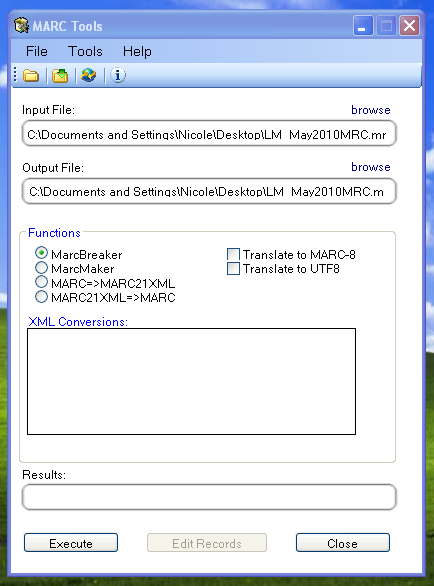
Ekranın en alt kısmına işlenen kayıtların bir özeti gelecek

materyal kayıtları eklemeye devam etmek için ‘Kayıtları Düzenle’ üzerine tıklayın
Ekran MARC kayıtlarını içeren daha geniş bir ekran ile değiştirilecektir
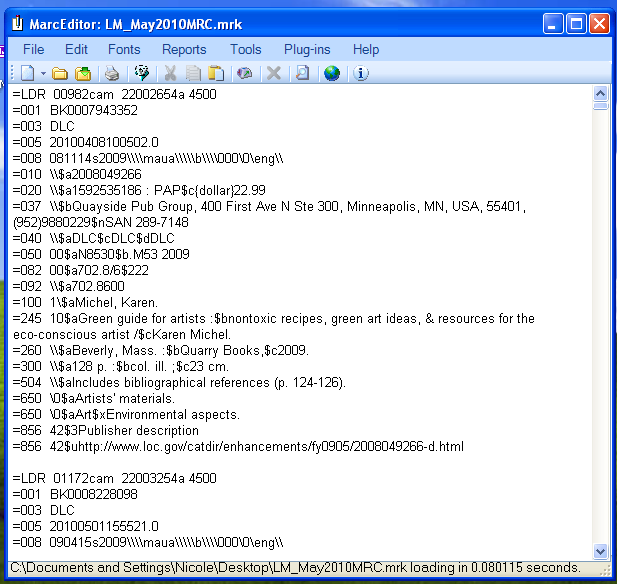
Araçlar > Alan Ekle/Düzenle üzerine tıklayın
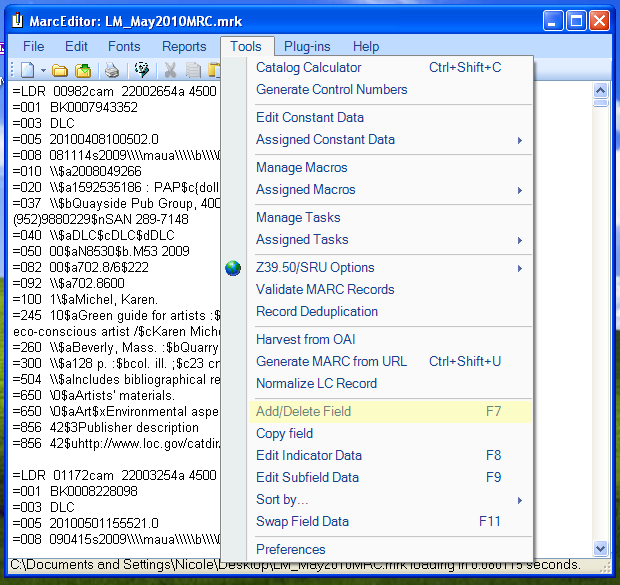
Koha özel materyal bilgisi içine girin

Alan kutusu içine 942 yazın
Alan veri kutusu içine \\$c ve materyal tür kodu (\\$cKİTAP bu örnekte) yazın
‘Insert last’ seçeneğini işaretleyin
‘Alan Ekle’ üzerine tıklayın
Materyal kayıt verisi içine girin
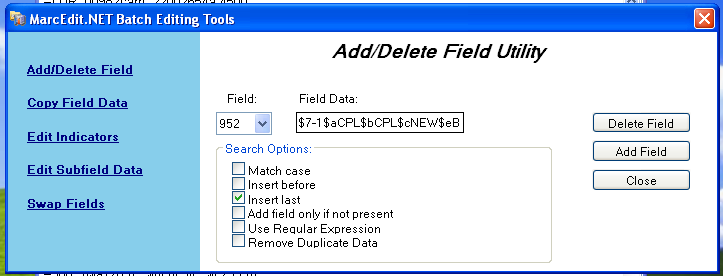
Alan kutusu içine 952 yazın
Alan veri kutusu içine $7ORDERED_STATUS$aPERM_LOC$bCURR_LOC$cSHELVING_LOCATION$eSOURCE_OF_ACQ$yITEM_TYPE yazın
ör. $7-1$aCPL$bCPL$cNEW$eBrodart$yBOOK
Varsayılan Koha kurulumunda -1 Sipariş edildi durumu değeridir
İçerisindeki veriler üzerinde düzenleme yapmak istediğiniz diğer alt alanlara bakmak isteyebilirsiniz – örneğin, tüm materyalleri aynı koleksiyona yerleştirmek için koleksiyon kodunu değiştirmek (8), sağlama tarihini otomatik olarak değiştirmek (d), ya da genel bir not girmek (z).
Alt alanları ayırmak için $ işareti kullandığınızdan emin olun; her alt alanı ayrı bir satır üzerine eklemek MARC kayıtlarınızla birlikte bir çok materyalin içe aktarılmasına neden olacaktır (yukarıdaki örnekte, her biri bu alt alanların bir tanesine sahip olan dört materyal düzeltilmiştir)
Alan içine doğru kodu yerleştirmek için Koha’da Yönetim > Yetkili Değerler’e baktığınızdan emin olun
‘Insert last’ seçeneğini işaretleyin
‘Alan Ekle’ üzerine tıklayın
Editör penceresini kapat
Dosya > MARC İçine Derle üzerine tıklayın
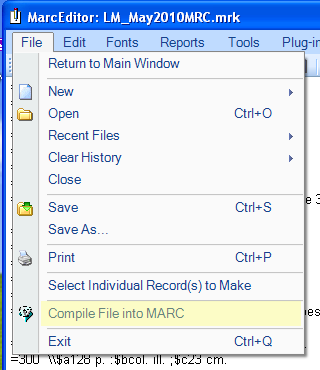
Dosyanızın kaydedileceği konumu seçin
Şimdi Koha sisteminize gidip MARC kayırlatını içe aktarma için yönergeleri izleyebilirsiniz.
Materyal geldikten sonra, bir kez materyal kaydına gidip materyalleri doğru barkoda sahip olması için tek tek değiştirmeniz, ve materyal durumunu manuel olarak Siparişte durumundan Ödünç Verilmez alanındaki boş satıra değiştirmeniz gerekecektir.
Not
Kataloglanmış materyal kayıtlarınızı satın aldıysanız sağlayıcınızdan ihtiyaç duyduğunuz bilgileri MARC kayıtlarına girmesini isteyebilirsiniz; bu şekilde sağlayıcı tarafından düzenlenmiş bilgileri içe aktarabilir, mevcut kaydın üzerine yazarak verileri otomatik olarak ihtiyacınız olanlarla değiştirebilirsiniz.

